Cockerels have three main purposes in a flock of chickens. They protect the hens by warning of any danger, they enable you to breed your own chicks, and they look fabulous. Sometimes, however, the cockerel’s protective instincts becomes a problem, and the bird becomes over-aggressive. This can be a particular issue in the spring, which is the breeding season.
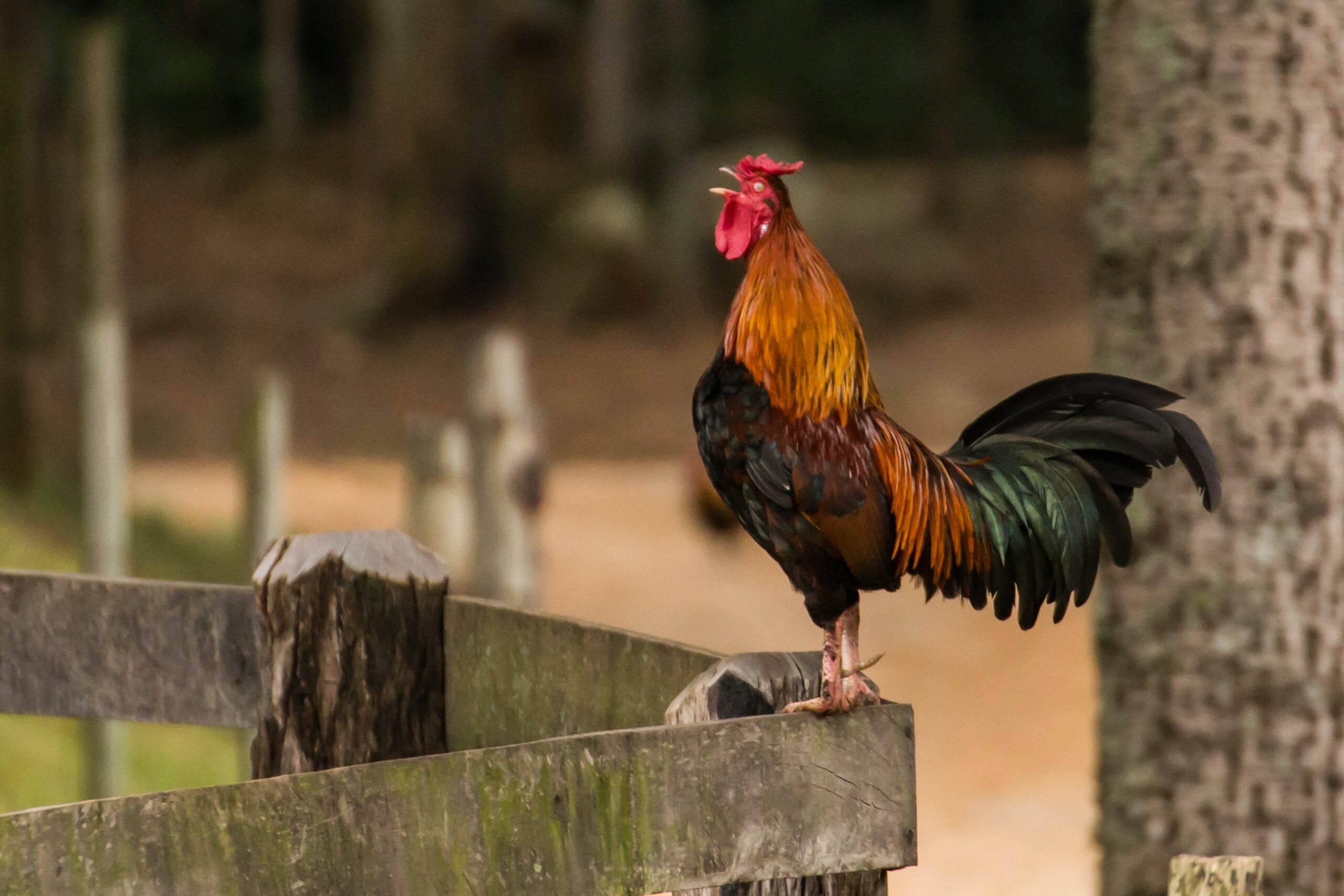
Cockerels are wired to protect their hens. If you watch the flock foraging in a garden, the loud clucking of a hen will bring the cockerel running to make sure everything’s okay. If a hen squawks when you pick her up, the cockerel will put on an aggressive display until you put her down again. As long as this doesn’t involve physical attacks, there’s no problem. Some cockerels will physically attack, though.
If these face-offs continue, the cockerel might decide that you – and all humans – represent danger and will try to fight you off at all times. Luckily, you can usually defuse the situation.
Cockerels give warning of their intention to attack. They lower their heads and perform a strutting dance while looking straight at you. Things get trickier if the cockerel decides to run up and attack your legs, like an angry farmyard goose. If you’re walking away, the cockerel may chase you from the yard, and that can cause nasty surprises too.
How Do You Stop a Rooster From Attacking You?
- Don’t walk straight towards the cockerel when you enter the place where the chickens are kept.
- Don’t stare at the cockerel unless he’s already behaving aggressively, as this is a sign of aggression as far as he’s concerned – you’re fixing your eyes on him and his flock just like a predator would.
- Don’t tiptoe around or run away if the cockerel looks at you, as these are signs that you’re afraid, and the cockerel might take this as a cue to rush in and finish the job!
- Don’t dash around the yard – the cockerel equates quick movements with predators. Go about your business in the chicken yard in a calm, slow but focused way.
- Make sure your hens are in a stress-free environment. If there are prowling dogs or unruly children running amongst the hens, their clucks and squawks will send the rooster into overdrive to protect his girls.
- If your cockerel brings you small ‘gifts’ such as stones or twigs, don’t be too flattered. He is treating you like a hen, and you will have to refuse the gifts and shoo him away, otherwise he will think he’s subdued you with his presents!
- Don’t crowd the cockerel. If he feels trapped in a corner, he is likely to fight his way out.
How to Handle an Aggressive Cockerel
Never respond to an angry cockerel with violence.
This will have no positive effect on the cockerel or flock’s behaviour afterwards, and it can result in serious injury to the bird. He may be aggressive, but a cockerel is still a bird, fragile bones and all.
A cockerel should be lifted with thick protective gloves to remove him to a safe place or away from the eye of the storm. Your arms and legs shouldn’t be bare when handling the rooster, and your footwear should be sturdy too. If the cockerel is only in the early stages of aggression, he can often be calmed down with a few treats. It is a good idea to carry treats with you whenever you’re in the same place as the cockerel. After you’ve fed him a few times, he will come to associate you with treats rather than danger. The treats should be hand-offered. If you throw them down and then run away, the rooster will recognise that you’re afraid, and the problems might continue.
A more hands-on – or feet-on – method is to gently roll the cockerel over with your safely booted foot when he approaches you looking for trouble. After a few of these gentle wrestling throws, the cockerel will realise that you’re the top bird in the run and give you no more trouble. In theory, at least!
How to Lift an Angry Cockerel
Alternatively, when the cockerel tries to peck you, scoop him up with your gloved hands and hold him like you would hold a hen, under your arm. The cockerel will flap and squawk angrily, but he will eventually calm down if you ignore these protestations. This may take 10 to 15 minutes, but it’s time well spent if it means that the cockerel will not attempt to attack you again.
If the cockerel has not yet attacked, you may be able to deter him by taking a large, deliberate step towards him, looking at him as you do so. If the rooster starts to fidget and looks at the ground or starts pecking it, you have won the battle, and you can back down without fear of attack.
The key to all these methods is to make the cockerel realise that you’re not a threat to his hens. Protecting the flock is all he wants to do. If that doesn’t work, and if the cockerel starts to stretch his wings and neck ready for attack, stretch out your arms. Carrying a stick can help here, as it makes your ‘wingspan’ look even greater in the rooster’s eyes.
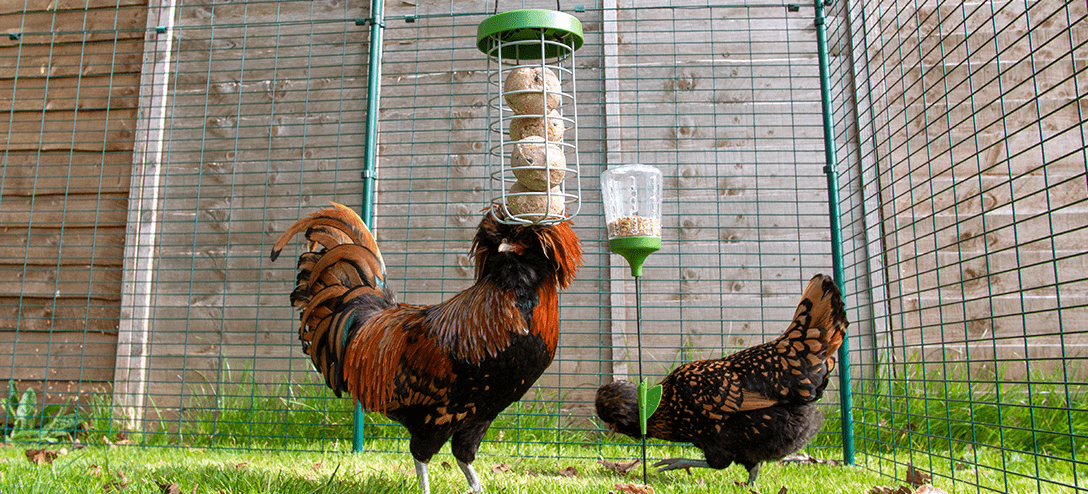
Treat holders and peck toys will keep your chickens entertained for hours!
What is the Most Aggressive Rooster?
Circumstantial evidence suggests that some cockerels are just born mean! In these cases, the cockerel’s instinct to protect a flock of hens is in constant overdrive. The aggression is occasionally seen when the birds are still chicks, although it is more usual for the aggression to kick in at 6 to 8 months old. Although the breed of the chicken makes a certain amount of difference, even supposedly gentle breeds can sometimes decide to take no prisoners in the chicken yard!
The most aggressive rooster breeds are said to be Aseel (allegedly the biggest bullies of all), Cornish, Leghorn, Malay, Old English Game and all other traditional ‘cockfighting’ or ‘game’ species.
What is the Least Aggressive Rooster?
The least aggressive roosters include the Australorp, Brahma, Polish, Silkie and Welsummer. Bantam breeds tend to be relatively calm, too. However, there are occasional ‘bad pennies’ in all breeds, and some cockerels just seem to hit an aggressive streak and never entirely leave it behind.
Constantly aggressive roosters are a real problem, especially if you have children wandering in the garden. A cockerel readily backs up his anger with a physical attack, and he is armed with sharp spurs – the spikes on his legs – that can do real damage. If all attempts to calm the cockerel down fail, the tyrant rooster will have to be rehoused.
If you have chosen a non-aggressive breed of cockerel, and if your chickens have lots of space, you will seldom have major problems with rooster aggression. Let cockerels know who’s boss as soon as they hit adulthood, never accept those tempting little gifts, and you should be recognised by all your chickens as being top of the pecking order.
This entry was posted in Chickens
Bird flu, also known as avian influenza, is back in the headlines, and new restrictions have been imposed on chicken keepers. In these circumstances, it is natural to ask whether wild birds present a major risk.

Wild birds are not the main source of the spread of the disease, however, even though they can act as reservoirs for the virus. It is human commercial activities associated with poultry farming that are the major cause of the bird flu’s spread across the world. If you are keeping just a few chickens, most of the risks can be avoided by simple hygiene and protective housing measures.
Avian influenza (bird flu)
As its name suggest, the avian flu virus is a form of influenza (flu) biologically adapted to bird hosts. Avian influenza is not a virus specific to chickens and poultry, and in theory any bird, wild or domestic, can be infected. The disease is always been at large somewhere in the world, and the safety risk for UK wild birds and bird keepers is currently quite high.
Bird flu – good news and bad news
In theory, any species of wild bird can catch the flu. Waterfowl such as geese, swans and ducks are thought to be major carriers of the disease, sometimes displaying no symptoms themselves. Chickens that come into contact with avian influenza are likely to catch it.
But let’s look at the good news first. The risk to human health from wild bird diseases, including avian influenza, are extremely low. In 99.9% of cases, humans affected by the highly virulent H5N1 strain of the bird flu have caught it from intensively reared poultry. The disease is not easily transmitted from human to human, and there have been no cases of avian influenza in humans in the UK, in spite of the safety risk for UK birds currently classed as high.
Similarly, chickens that are kept in runs and subject to common sense precautions are unlikely to catch the disease. Unless you live in an area suffering a major avian influenza outbreak, the visitors to your bird table are unlikely to be carriers of the disease.
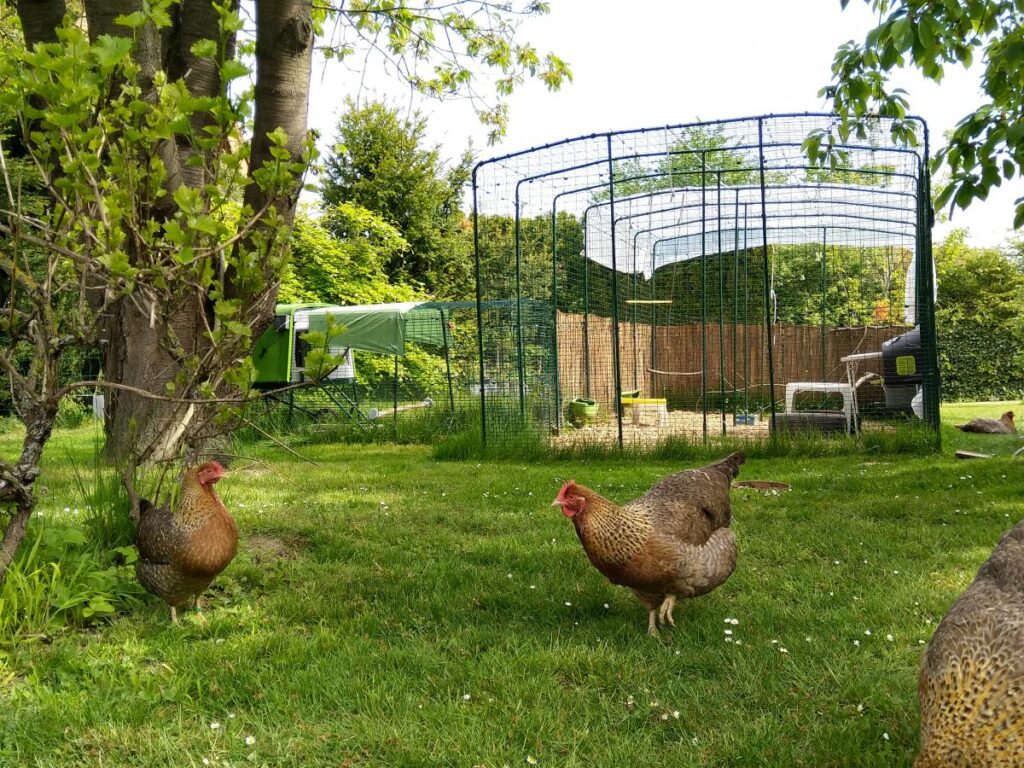
Now for the bad news… If only one wild bird in a thousand is a carrier of avian influenza, that’s still one too many. Like it or not, backyard chickens are at risk. This is why new rules and new housing measures were introduced in December 2020.
What are the new rules for keeping chickens due to bird flu?
On 14 December 2020 it became a legal requirement for all poultry keepers, regardless of the size of the flock, to keep their birds indoors and follow strict biosecurity measures to combat the spread of avian influenza. A joint statement from the three Chief Veterinary Officers announced:
“Whether you keep just a few birds or thousands, from 14 December onwards you will be legally required to keep your birds indoors or take appropriate steps to keep them separate from wild birds. We have not taken this decision lightly, but it is the best way to protect your birds from this highly infectious disease.”
All poultry keepers must implement these new housing measures and precautions until further notice:
- House all poultry and captive birds, or keep them in a run or fenced-off area outdoors
- Cover the runs or pens with a solid top to minimise wild bird droppings entering the enclosure
- Do not allow people other than the owners to enter the run or enclosure
- Implement effective vermin control (rats, etc) as these animals can spread disease
- Disinfecting clothing, footwear, equipment and other items used for cleaning the chicken coop and run, along with the feeders, drinkers, etc.
- Use the same pair of boots when entering the run or enclosure, and do not use this footwear for any other purpose (walking, shopping, etc)
- Make sure the chickens’ feed and water is separate from wild birds
- Keep weed wild bird tables and feeding stations away from the chicken run
Avian flu in wild birds
The chances of a human catching avian influenza directly from birds that visit the garden are practically nil. This is no reason to avoid basic precautions, however, especially if you keep chickens. Keeping bird feeding stations clean is important, to avoid droppings and moulds accumulating. These can impact the health of wild birds and lower their immune systems. You should always wash your hands after restocking or cleaning a feeding station, or after any situation that brings you into contact with bird droppings (feeding the ducks in the local park, for example).
Sick or dead wild birds should not be touched. In general, you do not need to report the discovery of a dead bird. However, if dead ducks, geese, swans, gulls or birds of prey should be reported, as should the discovery of five or more dead birds of any species in one place. In these situations, contact the Defra helpline (03459 335577; 0300 200 7840 in Northern Ireland).
How do I know if my chicken has bird flu?
Chickens with avian influenza will display various symptoms. They may be less active than usual, and will lose their appetite and show signs of nervousness. Their egg production will drop, and eventually their combs and wattles will look swollen, with a blue discoloration. Other avian influenza symptoms in poultry include coughs, sneezes and diarrhoea. Unfortunately, many of these avian influenza symptoms are associated with other ailments, too, so a vet will need to make the diagnosis.
It can take 14 days for an avian influenza outbreak to spread throughout a flock. Some infected birds may exhibit no signs, even though they are still potential virus carriers. Others may sicken and die very quickly.
How to treat avian flu in chickens
You can reduce the risk of avian influenza in your poultry by following the latest guidelines issued by Defra and the government. The NFU has a very useful page containing guidance and the latest news regarding bird flu.
Vaccination of a flock at risk from the avian influenza virus is the only method of prevention. If avian influenza affects a flock, the flock has to be put down.
This is from the Gov.uk website:
“All bird keepers (whether you have pet birds, commercial flocks or just a few birds in a backyard flock) must keep a close watch on them for signs of disease and maintain good biosecurity at all times. If you have any concerns about the health of your birds, seek prompt advice from your vet.”
The main takeaway messages
- The new rules about housing chickens apply to everyone
- Feeding wild birds in the garden is still safe
- Simple precautions and good cleaning regimes minimise the dangers
This entry was posted in Chickens
How cold is too cold for chickens? Chickens can tolerate cold weather, however, baby chicks are less likely to do so. The primary concern in cold temperatures is whether your chickens are becoming wet. If they are and cannot dry off, this can be cause for concern.
Our guide walks you through the optimum temperatures for chickens, how to care for your hens in winter, and which breeds are the most hardy.
How cold is too cold for chickens?
Chickens will regulate their temperature and behavior accordingly, so wherever humans can live, chickens can thrive too. Chickens can tolerate cold even under freezing temperatures. This makes caring for chickens in winter relatively simple, as only a few adjustments to your usual routine will need to be made. It is the combination of cold and wet that can prove fatal, so it’s vital to ensure your hens have a dry chicken coop. Any of your birds that become soaked should be toweled dry. Applying Vaseline to their combs will prevent frostbite and help them tolerate the cold.
Ideal temperatures for adult chickens
While chickens can tolerate the cold, their preferred weather is in the 70 degrees Fahrenheit range. You’ll find that your adult chickens can survive cold temperatures into the teens. However, we recommend keeping a thermometer in your coop to track its temperature. You should find that the insulation of your coop and the warmth created by the chickens themselves is enough to help them tolerate the cold.
Ideal temperatures for baby chicks
Baby chicks are far more sensitive to cold temperatures and are not able to tolerate them as well as full-grown hens. This is both due to their smaller size and the fact their feathers are not yet fully developed to keep them warm. When your chicks first hatch you should keep them at around 90-95 degrees Fahrenheit. After this you can reduce the temperature they’re kept at around 5 degrees a week until you get into the 70 – 75 Fahrenheit range.
Keep your chickens’ coop warm & cozy
The type of coop you have makes a big difference in how cold your chickens will tolerate. In really cold winters, a wooden coop with a drafty coop door can soon become damp and semi-frozen – not to mention very drafty. This dampness combined with the cold weather will make winter more difficult for be more tricky for your flock to tolerate.
On the other hand, a more robust state-of-the-art chicken coop such as the Eglu will keep out the cold and damp – enabling chickens to tolerate the cold weather after a busy day in their run. You’ll find that an Eglu will stay much warmer during the winter than a wooden coop. The temperature in the Eglu will remain moderate when all the hens are tucked in at night. Our Eglus are insulated by design, but if the winter becomes colder than usual you can easily add extreme weather protection to further insulate your coop.
You can help your backyard chickens keep warm in the frost and help them weather the cold by making sure the coop is clean and dry. Clear out any snow dragged in on the hens’ feet and keep an insulating layer of straw on the floor. Doing this will help your chickens to tolerate the colder weather. If you also insulate your chicken runs, there should still be some ventilation, to allow the gasses released from the birds’ droppings to escape.
An automatic door will help keep the living quarters cozy, too. It’s not advised to install a coop heater – even those rated for hen houses. Hens may get used to being overly warm all the time, which could be disastrous if the heater fails. Heat-pampered poultry can die of shock when introduced to lower temperatures, as they will not have become acclimated to tolerating the cold.
4 signs your chicken is too cold
When ensuring your chickens will tolerate the cold, it’s important to know the signs for when the weather may have made them uncomfortable. Here’s what to look out for:
- Ruffled feathers
- Perched off the ground
- One leg tucked up
- Wattles and combs are paler than usual
These are not signs of distress, and as long as the chicken is only having a brief rest, rather than staying hunkered up for the whole day, you don’t have to worry. If hens go off their feed, appear to be in shock, or have discolored (blue or black) combs, wattles or feet, it’s time to bring them inside to warm up slowly.
Keeping chickens dry in cold temperatures
While chickens can tolerate the cold, they should not be allowed to remain soaking wet. This is more dangerous than the outdoor temperature or the falling snow – and in extreme cases will result in hypothermia. Any affected hens will be stiff and cold to the touch, with their eyes wide and unblinking, or closed. If you find one of your chickens in this state, take them indoors and wrap them in a warm towel. When they recover, put them in a bedding-lined box in a warm spot for a few hours.
What happens if a chick gets too cold?
Chicks are less tolerant of the cold and are more susceptible to lower temperatures than adult chickens. If a young chicken has its full coat of feathers, it will be as tolerant of the cold as the older birds. Chicks, however, will need protection from the cold, and should be kept under an appropriate heat lamp. Any chick left to fend for itself in cold weather will die.
Tips for cold weather chicken care
Chickens can usually tolerate adapting to colder climates, but how can you tell when your flock needs a bit of help keeping warm? The following tips will help you keep happy, healthy chickens this winter:
- Prevent water from freezing – Check it at least twice a day to keep it clear of ice. If a freeze is forecast, bring the chicken waterers indoors at night. If possible, buy a water heater designed for the job of preventing freezing. Ping-pong balls in the water can also prevent freezing.
- Chickens usually return to the coop at dusk, but in the winter, you may find your birds trying to get more pecking time from the short days. If your hens tend to wander in the dark, a high visibility hen coat will help you locate them. The coats also keep the birds cozy, so it’s a double blessing in the Winter to help chickens tolerate the cold.
- Providing weather-proof shelter in the chicken run will give the hens some respite while tolerating the cold. You can use chicken run covers to do this.
- Some extra corn offered as a chicken treat before the hen’s bedtime will stoke their internal heater as the chickens digest it overnight. In general, hens will eat more food in the cold months to tolerate the cold, as more of their energy is spent keeping warm.
- Protect combs and wattles – from frostbite with petroleum jelly or Vaseline.
- Specially made coop heaters or brooder plates can be placed in enclosed spaces such as barns or garages for hens that are struggling in the cold, but should be used sparingly. And, these should only be used for a short amount of time, and only if someone will be home to avoid a potential fire-hazard.
- If you do not have a cozy Eglu, a wooden coop can be insulated with bubble-wrap, cardboard or old carpets or blankets.
- Extra bedding on the floor of the coop will help the chickens tolerate the cold, too.
- Some owners like to supplement their chickens’ diets with extra protein or a little suet, to increase their fat levels for the Winter. Fat retains heat, and the whole bird benefits from the added nutrition.
How do chickens naturally keep warm in the winter?
The chicken’s secret to tolerating the cold is natural insulation. Their feathers help them retain body heat and warm the air trapped beneath their downy base feathers. When they’re at rest, a hen’s body temperature is 104–107F, with their heart rate of around 400 beats per minute – evidence of a high metabolism that sets up the birds very well for winter weather.
Watching hens scratch at the frozen ground or strut through the snow, you might wonder how chickens manage to keep their feet and legs warm. After all, this is one part of their body with no feathers to keep it cozy (unless you happen to have a feathery-legged breed such as the Cochin, Brahma or Silkie). The answer lies in the chicken’s leg scales, which retain heat to a certain extent. The average chicken will always be on the move, not keeping all its toes on the ground for too long.
Does perching help chickens tolerate the cold?
Like many other birds, chickens often adopt the ‘one leg’ pose in the winter, tucking one of their limbs up into the warmth of their bellies. This reduces overall heat loss and stops feet and toes from freezing on the icy ground. Like all birds, chickens are warm-blooded, and their own body heat soon works its magic to help them tolerate the cold.
Perching is the most effective way for a chicken to retain body heat and tolerate the cold. Hens hunker down when roosting, with their feathers fluffed up and their legs tucked into her warm body. If space allows, install a flat perch in your coop or run. This will enable the hens to roost without having to curl their toes around the roosting bar, which will prevent their toes from freezing in very cold weather. An upturned pot, a log, pallet or other slightly elevated space will give the birds a flat surface to perch on, to escape the ice and snow.
Can chickens freeze to death?
Chickens can usually tolerate cold conditions and will not die, as long as they have a warm coop to retreat into when the weather becomes extreme. Cold hens may be more susceptible than usual to illness and parasites, though, and their egg production will fall. But, most chickens will simply hunker down on chicken perches and in nesting boxes, with their feathers fluffed out to weather the winter.
The best chicken breeds for cold weather
While most chickens can tolerate the cold, there are some chicken breeds that are more suited to cold climates than others. Here are the top 5 for cold temperatures:
Introducing Omlet pet care
Omlet can help you care for your chickens and ensure they’re enjoying each season to the fullest. From chicken pens to run around in, to toys such as chicken swings to keep them entertained, you’re sure to find everything you need to keep your flock healthy and happy all year round!
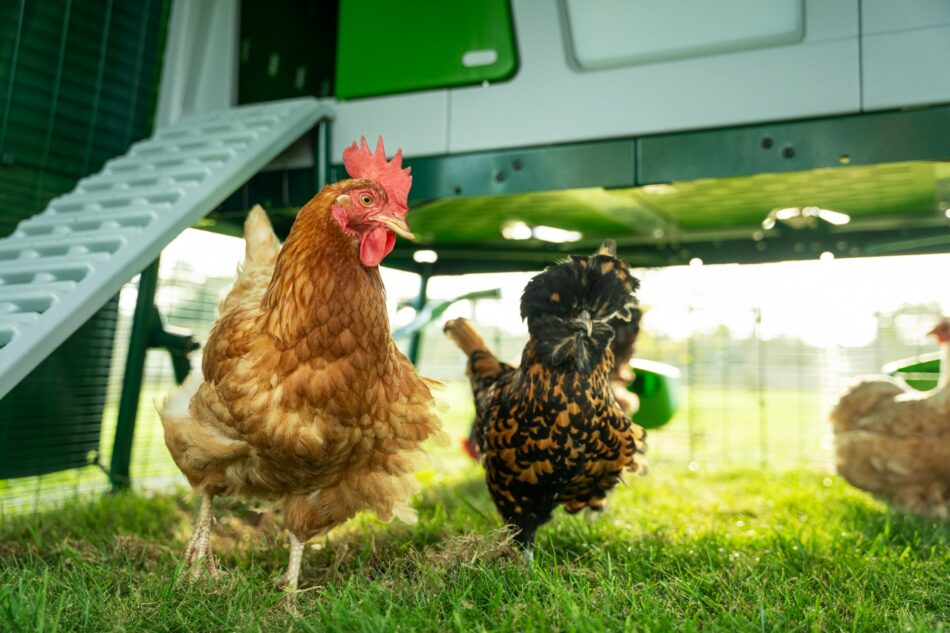
This entry was posted in Chickens
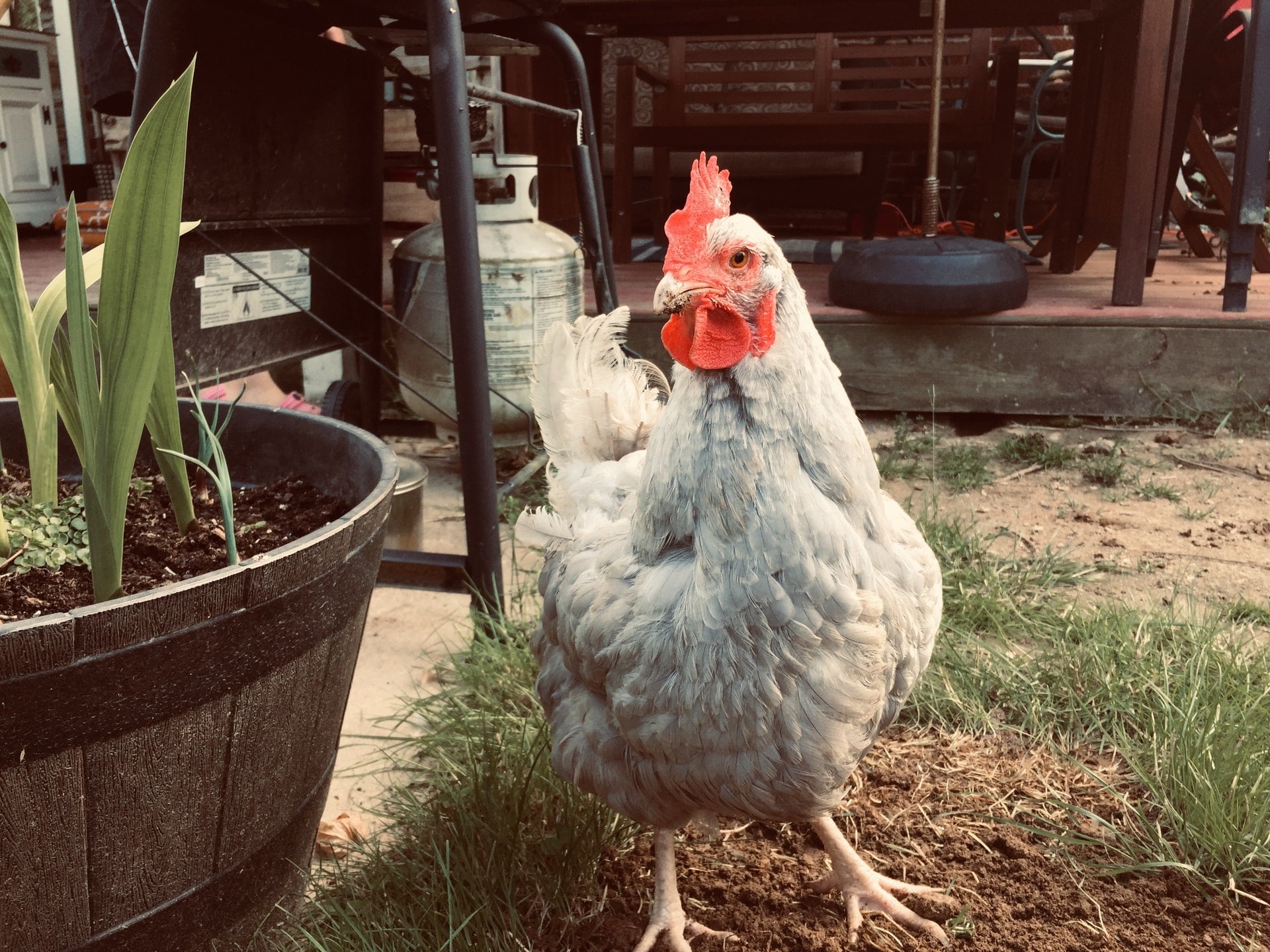
It’s nice to have chickens in your garden but they need to stay there! Seeing them fly away and attempting to catch them again is not necessarily the easiest of tasks. It’s stressful for everyone and sometimes even dangerous for your chickens! So what is the solution? Cut off their wings? Obviously not, but here are a number of flap busting techniques that may help to keep your feathery friends on the ground.
Why Does My Chicken Want to Fly Away?
If you are dealing with a runaway chicken it could be for several reasons. Each chicken’s character is different from one bird to another. While some like to lounge under a tree or in their chicken run, others prefer to frolic in search of freedom. This traveling and sometimes adventurous spirit can be associated with certain breeds of chickens. So, it’s not uncommon to find breeds such as the Leghorn or the Gauloise, for example, perched on a branch to rest. This is mainly due to their lighter weight in comparison to other breeds. Evolved with a fairly developed herd instinct, it only takes one chicken to take flight for the rest to follow suit.
However, sometimes your chickens may fly away, or even jump, not to rest but to escape a situation. A sudden or unusual situation can induce panic. A visit from a dog, the presence of a wild predator such as a fox, or the triggering of an unexpected high pitched noise can stress your hens and cause them to flee. They then have two options: run or try to fly. Under stress, fear and panic they can easily surprise you and fly higher than you think. They may even injure themselves in a panic to get away. So how do you avoid this kind of situation?
How Can I Prevent My Chicken From Flying Away?
There are three main precautions that can be taken when you have a flight-happy chicken:
- Choose a quiet but well placed area in your garden to set up your chicken coop. If you have space, keep the chicken coop away from potential dangers: roads, parking areas, children’s toys. Here, your chickens should feel safe. Their chicken coop is their home, they need to be able to eat, peck and sleep in peace.
- Invest in a fairly large enclosure. Having a high enough fence can deter them from trying to fly and protect them from potential animal attacks and external dangers.
An enclosed space, like the Walk in Chicken Run, is ideal for giving chickens a safe area to exercise and stretch their wings, without escape.
- The third precaution is often known to chicken owners, but it is not often applied. However, this is an elementary precaution when bringing a bird into a chicken coop. It regards cutting the feathers of a single wing in order to unbalance your chicken and stop them from being able to take flight. But how to do it? Take a pair of clippers and cut the flight feathers, that is, the larger feathers. You can also cut the primary and secondary flight feathers. The feathers must be cut halfway for it to be effective. Rest assured, we only cut Keratin (what our hair and nails are made of). It’s like going to the hairdressers!
Find the tutorial video “How to Clip your Chickens Wings (Safe and painless) (Easy to do)” by here.
Providing a comfortable living space, and large, safe enclosure will keep your hens happy and healthy in their home. And if necessary, wing clipping can be an effective solution for particularly determined escapees.
This entry was posted in Chickens

Most chicken keepers will fall into the eventually of “chicken math”. First, it was three, then four and now you’re thinking an eighth hen wouldn’t hurt…right? The idea of having flockmate best friends sounds great, but being the same species isn’t always enough for chickens to live in harmony. Certain chickens get along better than others, but which breeds make for besties?
Normal chicken behaviour
All different breeds of chicken have been developed from the same ancestor, the Asian Jungle Fowl, and so fortunately, most chickens get along, regardless of the variety. However, there are some exceptions to this general rule.
Any new hen introduced to a flock will need to be separated from the other birds, but still be able to see them through a fence, for a week or so until all the birds get used to each other. Once introduced, they will find their natural place in the chicken pecking order, and that may involve a little bullying and squabbling in the early days. This is all very natural and has nothing to do with feuds between specific breeds.
Occasionally, one hen will fall out with another for no obvious reason, and the weaker chicken will sometimes be pecked and harassed by the more aggressive bird. If this situation continues for more than three days after introducing the new chicken, the two combatants may need to be separated.
What breeds of chickens are aggressive?
Some chicken varieties are more confident and assertive than others, but this does not make them aggressive. Aggression is usually the result of environment – poor living conditions – or visual stimulus. The chicken bullying only usually persists beyond the first few days if the new hen has unusual plumage on its head. The fancy crown of feathers on the Araucana, Houdan, Poland, Silkie and Sultan breeds, for example, is like a red rag to a bull for some hens.
The reasons for this aggression are purely instinctive. Chickens respond to the size of their fellow birds’ combs, and there is evidence that larger-combed chickens tend to dominate the pecking order and will challenge any large-combed newcomer to assert and retain her dominance. No one is entirely sure how the visual stimulus works with feather-crowned breeds. A chicken with feathers on its head is judged by the other hens to be one of two things – either a bird with a very large comb, and therefore a threat, or one with no comb at all, which makes it fair game for some bullying. Whichever way a hen looks at it, the feather-headed newcomer is a direct challenge to the dominant birds.
Birds with fancy head feathers are additionally vulnerable because the plumage flops in front of their eyes, impairing their vision, and so they may not spot an oncoming attack. This can result in pecks and injuries.
Other causes of chicken bullying
Other unusual feathering will occasionally inspire bullying amongst chickens, such as the feathered ‘trousers’ of the Faverolles. This is not generally a problem, though, and this breed should get along well with your other hens.
Sometimes, new chickens with no unusual feathers or peculiar combs may be picked on if they are a different breed from all the other hens in the flock. The bullying appears to take place simply because the new chicken looks different to the others. This is an unusual issue, though, and clearly, the problem disappears if your existing hens are a mixed breed flock.
Do chickens bond with each other?
In general, mixing breeds actually assists with the pecking order and the general bonding, as different varieties have different temperaments. There is more likely to be squabbling in a run that has chickens of a single breed – they may all be assertive and dominant, or they may all be shrinking violets, depending on the breed, but they still need to establish a pecking order.
The body size of the hen does not affect how it is treated. A dainty bantam can rub along fine with a hulking Sussex, and a cockerel will be respectful of all his hens, regardless of their breed, and in the vast majority of cases the birds will all get on well together.
There are other practical considerations when keeping a mixed flock. Some chickens thrive in cold weather, while others are not as robust. Age may be an issue too, if you want to minimize the number of changes in your chicken flock. This isn’t to say chickens of different ages can’t get along but older chickens are more likely to bully other flock members. If possible, wait until your younger birds are close in size before moving them in.
What chicken breeds get along best?
Some breeds are naturally friendly, and these varieties are far less likely to start pecking and bullying each other. Super-chilled backyard chickens include Australorps, Cochins, Easter Eggers, Rhode Island Reds, Silkies, Sussex and Wyandottes.
Omlet and your flock
Whether you’ve got a flock of ten or two, Omlet has the products to support the needs of your chickens. Keep your hens mentally and physically stimulated to help them live in harmony with our range of chicken toys and accessories to add to your chicken coop and chicken run.
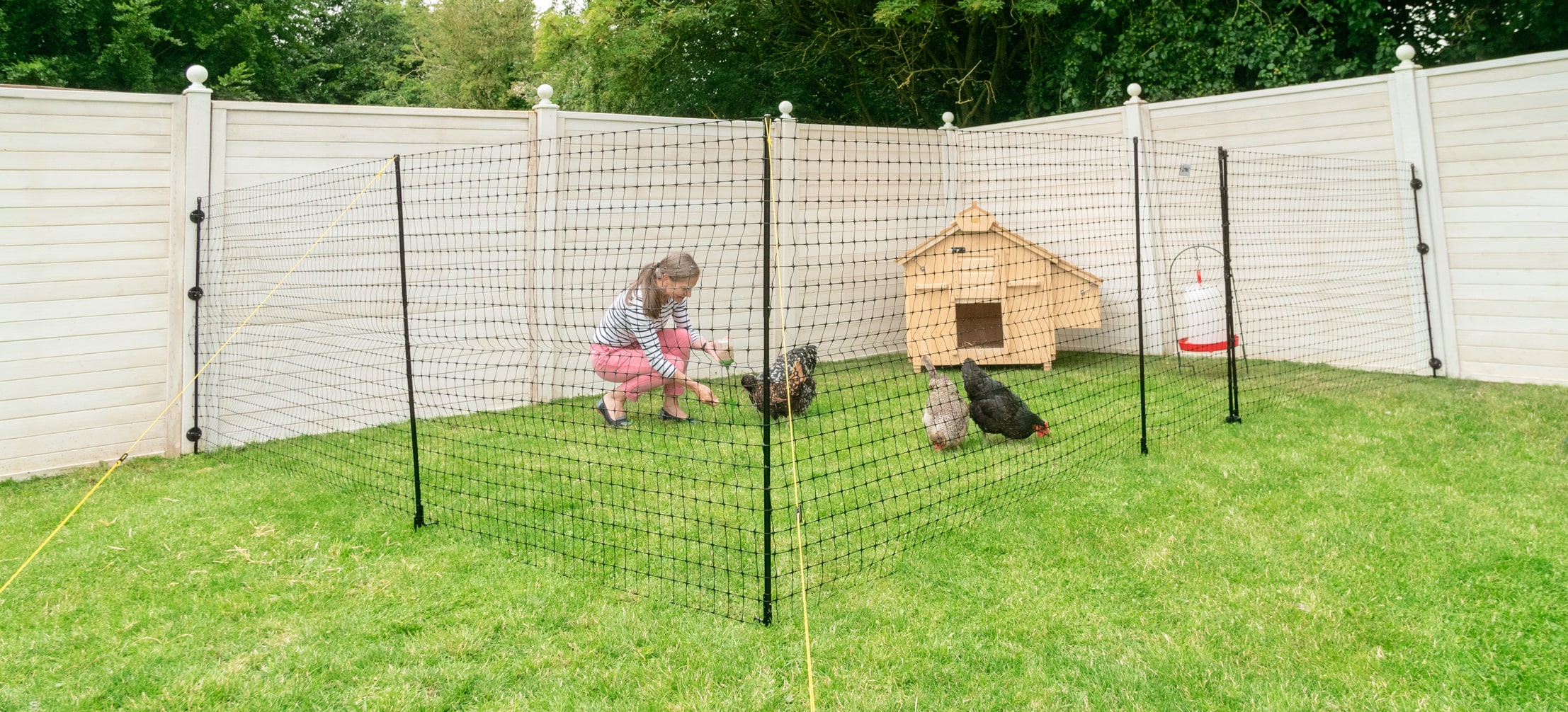

This entry was posted in Chickens
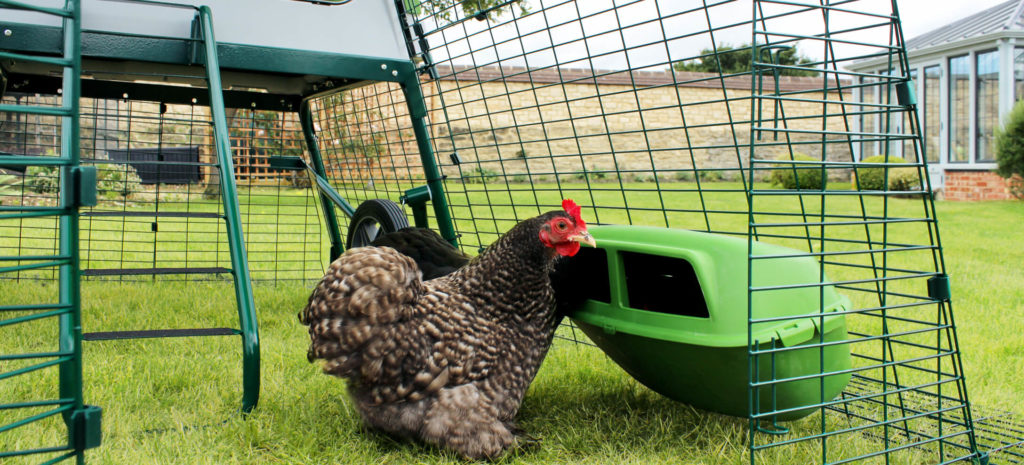
Important update on 19th March 2021 from gov.uk:
“The risk of avian influenza to both wild and kept birds has reduced to ‘medium’. The Avian Influenza Prevention Zone (AIPZ) requiring enhanced biosecurity will remain in force but Wednesday 31 March 2021 will be the last day poultry and other captive birds will need to be housed (housing restrictions end 23:59 31 March 2021). Bird gatherings are still prohibited. High standards of biosecurity remain essential as infection may still be present in the environment.”
Important update on 3 December 2020 from gov.uk:
“The Chief Veterinary Officers for England, Scotland and Wales have agreed to bring in new measures to help protect poultry and captive birds. The new housing measures announced on the 3 December 2020, which will come into force on the 14 December 2020, mean that it will be a legal requirement for all bird keepers to keep their birds indoors and to follow strict biosecurity measures in order to limit the spread of and eradicate the disease.”
Avian Flu is an issue that affects all chicken keepers. Efforts to contain the virus never result in its eradication, and the fact that it is not currently in the headlines doesn’t mean it’s disappeared. Many countries are enduring the avian flu version of lockdown in certain regions this year, and people are being told to take appropriate measures.
There have been local outbreaks in the UK, Germany, Denmark and the Netherlands in the second half of 2020. The current avian flu strain in Europe is a low pathogenic avian influenza, meaning that it is highly unlikely to spread from its bird hosts to humans. The ghost of a bird flu pandemic cannot be ignored, though.
The outbreak is thought to have originated in western Russia and Kazakhstan, following the same pattern as the avian flu outbreaks in the summers of 2005 and 2016. In both previous cases, epidemics soon spread to northern and eastern Europe.
This article describes the impact of pathogenic avian influenza, how it spreads, and what chicken keepers can do to prevent it, based on government guidelines and other practical measures.
What is avian flu?
As its name suggest, the avian flu virus is a form of influenza (flu) biologically adapted to bird hosts. Bird flu is not a virus specific to chickens and poultry, and in theory any bird, wild or domestic, can be infected. The reservoir of avian influenza is, indeed, flocking wild birds such as geese and gulls.
Symptoms of avian flu in chickens
Chickens with avian influenza will display various symptoms. They may be less active than usual, and will lose their appetite and show signs of nervousness. Their egg production will drop, and eventually their combs and wattles will look swollen, with a blue discoloration. Other avian influenza symptoms in poultry include coughs, sneezes and diarrhoea. Unfortunately, many of these bird flu symptoms are associated with other ailments, too, so a vet will need to make the diagnosis.
It can take 14 days for an avian influenza outbreak to spread throughout a flock. Some infected birds may exhibit no signs, even though they are still potential virus carriers. Others may ail and die very quickly.
How to treat avian flu in chickens
You can reduce the risk of avian influenza in your poultry by following the latest guidelines issued by Defra and the government. Vaccination of a flock at risk from the avian influenza virus is the only method of prevention. If avian influenza affects a flock, the flock has to be put down. Links to the latest UK government advice is given at the end of this article.
How to protect your chickens
- Place your birds’ food and water in fully enclosed areas that are protected from wild birds, and remove any spilled feed regularly.
- Keep your equipment clean and tidy and regularly disinfect hard surfaces.
- Clean footwear before and after visiting your birds.
- Ensure clothing that you use when handling your chickens is washed after contact.
- Use run covers to protect your chickens’ enclosure from wild bird droppings.
- Keep moveable coops in the same place – if coops are moving to fresh ground there is more chance of coming into contact with wild bird faeces.
- Keep a close eye on your chickens. If you have any signs of illness, seek advice from a qualified vet.
Areas in the UK affected by avian flu in 2020
The latest cases of avian influenza virus amongst chickens and other poultry occurred in the Melton Mowbray region of Leicestershire in November 2020, with the other affected areas located south of Liverpool and in the Leominster region of Herefordshire. There are 10-kilometre exclusion zones in place at these locations, and there are dozens of other areas observing a 3-kilometre exclusion zone based on the risk from wild birds. The Department for Environment, Food and Rural Affairs (Defra) has an up-to-date interactive avian influenza map showing all the areas affected by restrictions in England, Scotland and Wales. Not surprisingly, areas adjoining the island’s various estuaries, firths and The Wash, are affected, and anyone keeping chickens in these areas needs to be up to date with the latest government advice and regulations.
The UK government recommends registering your hens (and any other poultry), which will ensure that you receive the latest advice regarding the flu. If you keep over 50 hens, registration is a legal requirement, as you are then, by definition, a poultry farmer. Farmers who do not comply with regulations regarding avian flu can be imprisoned for up to three months or face unlimited fines.
“The risk of HPAI incursion in wild birds in the UK is HIGH. The overall risk of infection of poultry in the UK is MEDIUM; although it should be noted that the risk of introduction to individual premises depends upon the level of biosecurity implemented on farm to prevent direct or indirect contact with wild birds.”
(Official advice about biosecurity can be found here: https://www.gov.uk/guidance/avian-influenza-bird-flu#biosecurity-advice)
“Bird flu is a notifiable animal disease. If you suspect any type of bird flu in poultry or captive birds you must report it immediately by calling the Defra Rural Services Helpline on 03000 200 301. In Wales, contact 0300 303 8268. In Scotland, contact your local Field Services Office. Failure to do so is an offence.
If you find dead wild waterfowl (swans, geese or ducks) or other dead wild birds, such as gulls or birds of prey, you should report them to the Defra helpline (03459 33 55 77 – please select option 7).”
*Advice correct as of 25th November 2020.
This entry was posted in Chickens

Eglu Cube / Eglu Go / Eglu Go UP
This is the ideal time to treat yourself to that chicken coop you have been dreaming about! If would like to start keeping chickens in the new year, the Eglu Go or Eglu Go UP are brilliant starter coops for 3-4 hens. If you currently have a smaller Eglu, or keep chickens in a coop that is starting to look a bit worse for ware, you might want to consider investing in an Eglu Cube, our largest chicken coop with space for up to 10 small bantam hens.
All Eglus are super safe, very easy to clean and can be moved around the garden as often as you like. This makes life easier and more relaxing for both you and your pets!
Eglu Chicken Coops are currently discounted by up to 20% in our Winter Sale!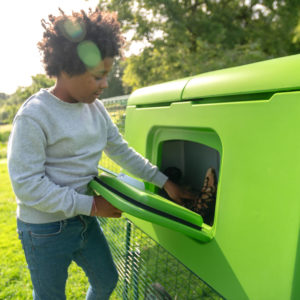
Chicken Accessories
Omlet’s amazing range of Chicken Toys and Accessories make great Christmas gifts for chicken keepers of all ages. Interactive food toys like the Poppy and Pendant Peck Toys and the Caddi Treat Holder that can be filled with fresh veg and hung from the roof of the run will entertain chickens during the cold winter months, as will the super fun Chicken Swing and the more traditional Chicken Perch.
All these accessories are currently significantly discounted, so why not take the opportunity to get the whole hentertainment bundle?
Boughton
If you’re planning to treat a traditionalist that prefers to keep their hens in a wooden chicken coop this Christmas, we’ve got just the house for you. The timeless, yet practical, design of the Boughton makes it easier to keep chickens happy and healthy, and any chicken keeper will enjoy seeing the coop in the garden every morning. It also comes untreated, so that the person getting this very generous gift can decide what look they would like to go for!
The Boughton is now 15% off in the Omlet Winter Sale!
Click here for full terms and conditions.
This entry was posted in Chickens

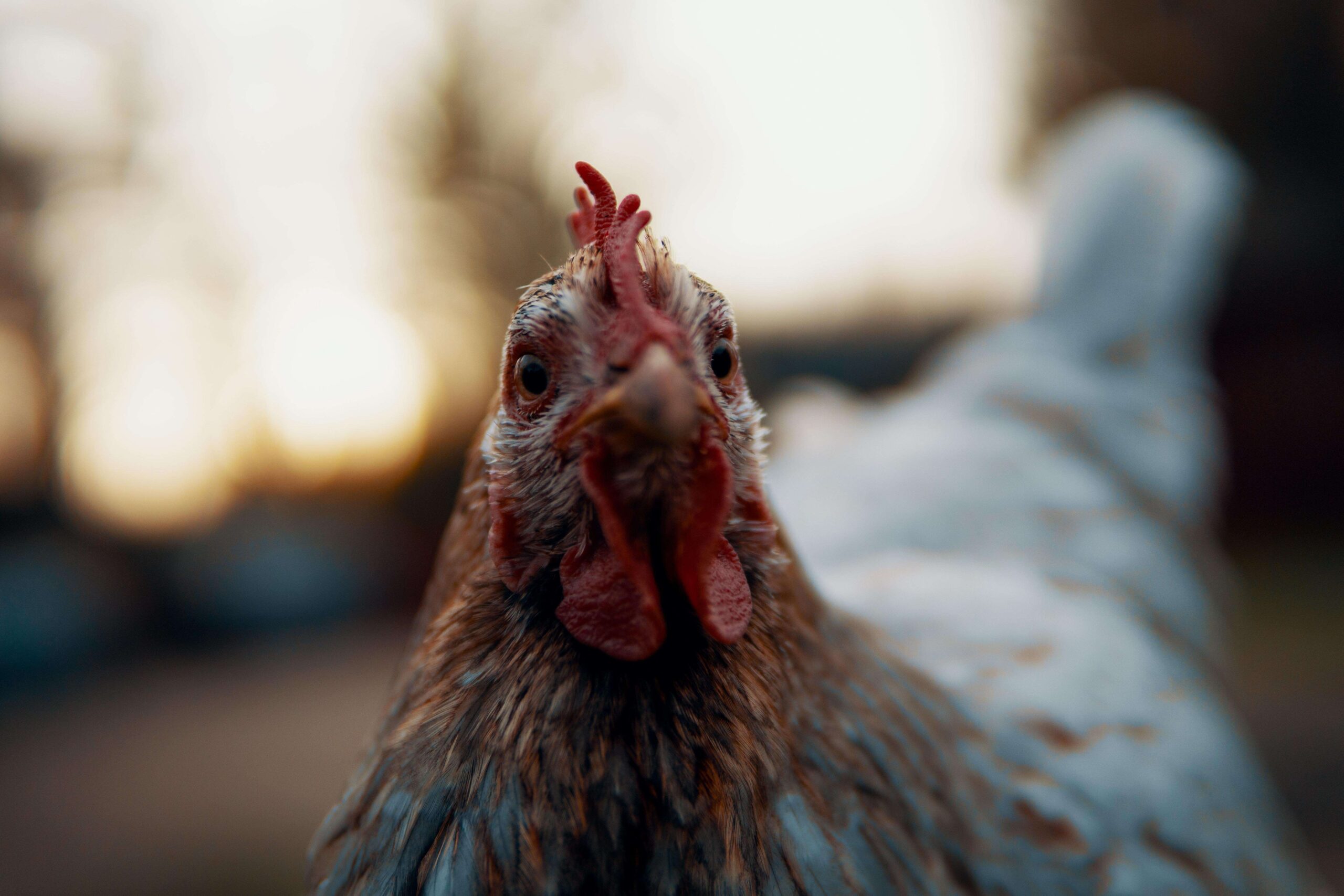
Only very tame pet hens enjoy being picked up. Most chickens find the whole procedure stressful, so you should only catch or handle them if you have to.
There are a few reasons why you might need to know how to catch a chicken. Your hens might be in danger, might require a clean-up after coming into contact with something oily or sticky, or you might need to carry out a chicken health check.
There are various ways to catch a chicken. If the hen is in danger as a result of escaping onto a road or into a garden with a dog in it, you can usually manage things by ‘herding’ the chicken rather than trying to lift it. If a dog is the problem, controlling or confining the dog is the first thing to sort out. If the hen has escaped and you need to catch her, guiding her back to safety by standing with your arms stretched out to the sides and encouraging her to return to the chicken coop is the best option. In these situations, the chicken will desperately want to find her fellow hens, so ‘steer’ her towards the hole in the fence or the open gate, or whichever escape route she took.
If the hen has flapped over a wall, however, you may have to resort to old fashioned hunting techniques for catching chickens.
How Do You Catch a Stray Chicken?
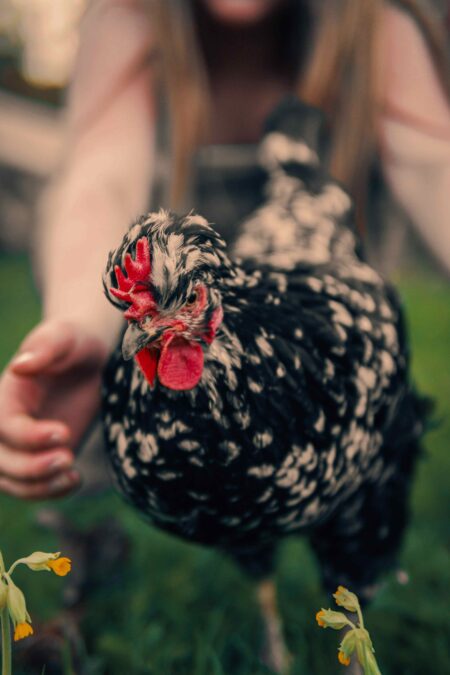 If your hens are very tame, you can simply offer some treats, bend down and pick them up. If only it were that easy with every chicken! Some are about as easy to catch as a fast-moving bar of wet soap – they can sprint at speeds of around 9 miles (14.5 km) per hour – and you will usually have to corner them first if you want to catch them.
If your hens are very tame, you can simply offer some treats, bend down and pick them up. If only it were that easy with every chicken! Some are about as easy to catch as a fast-moving bar of wet soap – they can sprint at speeds of around 9 miles (14.5 km) per hour – and you will usually have to corner them first if you want to catch them.
If a hen has escaped or you spot her running away, or simply hidden somewhere in a large garden or meadow where you can find to trace of her, the best approach is to be patient and rely on the chicken’s homing instinct. As dusk begins to fall, the hen will instinctively head back to the coop. This is one of the handy things about keeping poultry!
The Best Way to Catch a Chicken
Do chickens like being picked up? In general, the answer is no. But if you’re trying to catch a chicken for whatever reason there are various ways of doing so. Not all of them can be recommended for the non-expert chicken keeper.
- Using a net to catch chickens. Nets can be dangerous tools, as a chicken’s claws can snag in the netting, causing injury. If you opt for this method, the chickens should be netted as quickly as possible to minimise stress – although forever afterwards the sight of that net will send the poor hen into a panic! You should always use as large a net as possible for catching your chickens. A blanket may offer a safer way to catch them.
- Using crate traps for catching chickens. Putting irresistible treats into a crate, and then slyly closing the door with a pole or long stick is an effective method. The main drawback is that all the other chickens will be tempted to take a look inside too!
- Boxes for catching chickens. A large box can be placed over a cornered bird in the coop or run, and the flaps can be tucked in to secure the chicken. This technique can be useful if you need to capture chickens in daylight (although it works at night, too) and if they tend to be aggressive.
- Torchlight makes chickens easier to catch. This is the simplest and most effective method when you need to trap a roosting chicken. When chickens are with the rest of the flock in the coop or run on their roosting bars or perches or in their nesting boxes at night, they instinctively stay put. If you open the top of the coop and shine a torch in (head-mounted ones are perfect), you’ll be able to pinpoint the hen you need to examine, and grab her up with minimal fuss.
Picking Up the Chicken
When picking up the hen, try to be firm but not rough. Getting a good grip and preventing the wings from flapping is the key. The correct method is to hold the chicken by placing your hand over its back, confining the wings, and then bring it close to your body. If the bird is very nervous, you may have to cover her with a towel to calm her down.
A tame hen is the easiest type of chicken to capture. Simply lure the hen in with a few treats, and grab her, stroking her back to reassure her. Once the cleaning or the examination is over, put the chicken on the ground and step back. She will do the rest, scuttling back to the safety of the flock.
So, there are several ways to catch a chicken, but you should only put them into operation when you definitely need to catch one. Try to avoid the poultry hook or net if you can, and use the method that suits both the chicken and the circumstances.
This entry was posted in Chickens

Moving house is stressful for everyone involved – and that includes pets and chickens. As far as your hens are concerned, the secret to a successful relocation is to have everything ready at the other end. In the same way as you might unpack a kettle and two mugs before opening any of the big boxes, the chicken shed and run should be ready in the garden before the first kettle boils!
Hens are prone to stress, and at the very least you can expect the egg count to plummet for a few days following a move. Weak or very nervous chickens are in particular danger, as panic can make them flap blindly and break legs, or even kill themselves. Minimising stress is therefore the key to a successful move.
The most stress-free way to get your hens ready for the move is to collect and crate/box them from the coop, rather than later in the day when they are out and about and need chasing and cornering. That is not a good way to minimise stress!
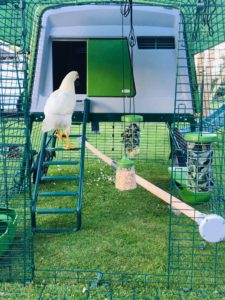 Transporting Chickens
Transporting Chickens
Your hen-carriers need to be covered, well-ventilated boxes or pet crates. They should have enough space for the birds to turn around in (to prevent them from panicking at the confined space), while being dark enough to make their instincts kick in and help them snuggle down for the duration of the trip. On longer journeys, however, you will need to have enough light in the boxes to enable the hens to feed, and pet crates will make this easier.
You’ll need one box per chicken, generally, so make sure you have enough boxes for the big day. Hens with similar, placid temperaments can be transported in a single box. Each box or crate should be lined with straw to soak up the droppings, and the boxes should be stacked securely, not more than three boxes high.
It’s important that the birds don’t get too hot on the journey, so ventilation is an issue. If you only have two or three hens, they could travel on the back seat of a well-ventilated car, secured with quilts or blankets – or even seatbelts – to prevent the boxes from sliding around.
The journey itself should be taken using as many straight, non-bumpy roads as possible, combined with the need to make the trip as brief as you can. If your new home is a short stretch of motorway and a couple of A-roads away, that’s all very straightforward. Rural locations with lots of windy-road options will need more planning. If all the roads are B-roads with lots of bends, the quickest route is the best option.
In the two weeks before the move, make sure your hens’ diet is rich in all the required vitamins and minerals. Some owners recommend adding probiotics or extra vitamins to the feed, and this is something you should discuss with your vet.
For short journeys, you will not have to worry about chicken feed. On longer trips, though, food will need to be provided. Make sure you take a long break at least every three hours, to allow the confined birds to settle down and feed. If you are transporting the hens in crates, you can attach a water dispenser to the side.
A Portable Chicken Coop?
Old fashioned chicken coops can be tricky to transport, and many hen keepers prefer to erect a new run and chicken shed at their new property. This sometimes involves housing the birds in temporary accommodation while the new coop and run are being sorted out.
There are ways of avoiding the inconvenience, though. A portable coop and run can be packed away and then installed in the new garden in a few minutes, and they have the advantage of familiarity. Hens introduced into a coop that they already know inside out will reduce the stress of the move enormously.
Coops and runs such as the Eglu are ideal in this respect. Placing the coop in your new garden as soon as you arrive will enable the chickens to feel at home before you’ve even managed to open any of your removal boxes. Human will inevitably feel the stress of the moving-in process, but the hens don’t have to!
The process isn’t quite over when your hens are safely cooped up in the new garden. Stress can cause any underlying diseases to bloom, so you need to carry out daily health checks on your birds as the flock settles down in its new surroundings. This is yet another reason to consider a pack-and-go portable coop and run.
This entry was posted in Chickens
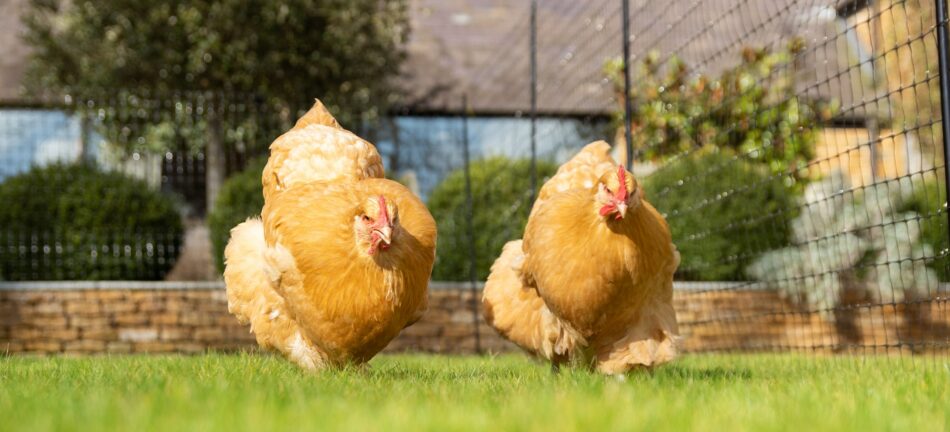
As with all pets, chickens rely on their owners for their safety and wellbeing. But as humans, vacations, spontaneous trips, and other time away from home are inevitable. So how will your chickens manage while you’re away?
Chickens are fairly self-sufficient, and do well when left alone. They don’t have separation anxiety from their owners like some pets experience, and can entertain themselves as long as they have their flock for company. Chickens will also regulate their feed intake and not overeat if free-choice food is left out for them. Still, they are prey animals, and certain considerations need to be taken into account before you take an extended leave of absence – particularly if no one will be staying with them while you’re away.
How long can I leave my chickens alone for?
Every chicken keeper does things a little differently from another, so the amount of time you can spend away from your flock is largely dependent on how you have them setup. Do they free-range, or are they always in a coop and run? Do you have an automatic door to tuck them in at night? Do you leave feed out, or feed them a portion daily?
When you prepare your chickens for your absence, you’ll need to make sure they have access to plenty of food and water. You’ll also need to make sure that they stick to their regular schedule as closely as possible. If they’re accustomed to free-ranging during the day and being closed in at night, you’ll need to have a safe, contained space large enough to simulate free-ranging.
An Eglu Cube chicken coop connected to a walk in chicken run is a great option for chickens that are accustomed to free-ranging, or for flocks that crave space during their time out of the coop. The run can be extended to however large you’d like to make it, so space is never an issue. And with the anti-dig skirting, predators will be deterred from coop-crashing while you’re away!
Give the setup and routine that you plan to have while you’re away a trial run before you leave to make sure everything goes smoothly. If any changes need to be made before you leave, you’ll want to give your flock ample time to adjust. Chickens will adapt quickly, so if your trial run was a success, your chickens should be just fine if you’re gone over the weekend.
Should I get a chicken sitter?
Leaving chickens alone for a day or two is commonplace for most flock-raisers, but if you are gone longer than that, it’s a good idea to have someone come and check on your chickens while you’re away. Depending on the time of the year, chickens can go through their feed and water quickly, and one misplaced step or a visit from some neighbourly mice can empty a food or water container in a hurry!
Consider asking a neighbour or a family friend that enjoys chickens to stop by and check in with your hens. A quick glance is often all it takes to ensure your flock is thriving while you’re away. You can always offer for them to take whatever eggs your hens have laid while you’re away as repayment and token of your (and your hens’) thanks!
If you have an automatic chicken coop door, be sure to let your chicken sitter know what time it opens and closes, or ask if they have a preferred time to go and check on your flock. Make sure to reprogram your automatic chicken coop door (if open or close times need to be adjusted) well in advance to get your hens accustomed to a different bedtime if necessary!
What do my chickens need while I’m away?
Food and water
Make sure to fill all of your chickens’ feeders and waterers before you leave. If possible, anchor any free-standing feeders or waterers to the sides of the run or coop to prevent them from being knocked over. Keep waterers sheltered from blowing debris to prevent them from getting clogged.
Prep for different weather
Consider the time of year you are leaving and plan accordingly. Always prepare for precipitation – even if there isn’t any in the weather forecast! Make sure your chicken run cover is on to provide shade and protection from rain.
Entertainment
If your flock is used to daily visits and treats from you, they will likely miss it while you’re away! To head off any treat-pining or fear of missing out on playdates, offer some fun alternatives such as a Chicken Swing or a variety of chicken toys to keep them occupied. To really stay in their good graces, set out some treats in a chicken peck toy or Caddi Treat Holder. Your flock might not even notice you’re gone!
Good to go
With proper preparation and planning, travelling can still be part of your lifestyle when you have chickens. The easiest way to maintain a flexible schedule with chickens is to create a setup that allows for flexibility from the beginning.
It’s always easiest to start off with the ideal setup for your flock so that your future travel plans don’t interfere with their routine. Large chicken coops with walk in runs, automatic chicken coop doors, and weather protection are all components of raising happy and safe chickens – whether you’re home or not!
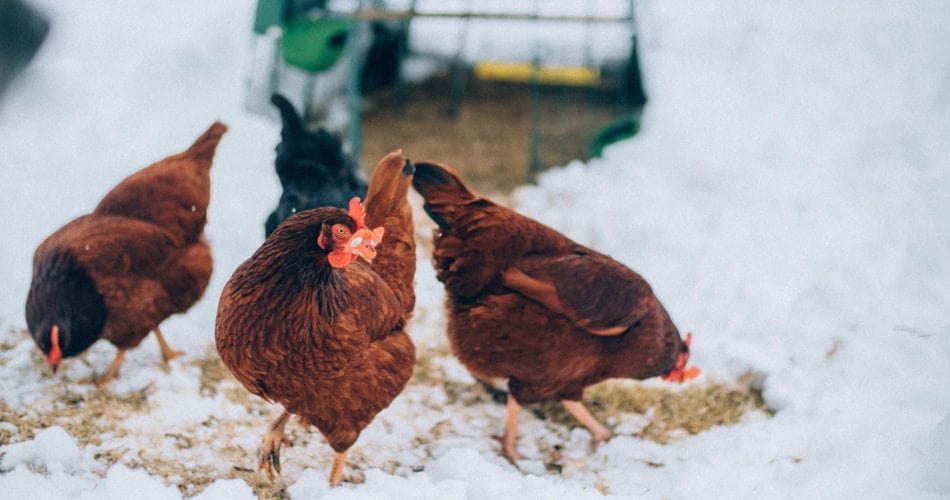
This entry was posted in Chickens
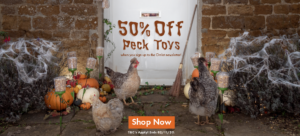
Trick or treat your hens this Halloween with a s-peck-tacularly spooky Peck Toy! Save 50% on Peck Toys when you sign up to the Omlet newsletter!
Terms and conditions
This promotion is only valid from 29/10/20 – midnight on 02/11/20. Once you have entered your email address on the website you will receive a discount code that can be used at checkout. By entering your email you agree to receive the Omlet Newsletter. You can unsubscribe at any point. This offer is available on single Poppy and Pendant Chicken Peck Toys only. The offer does not apply to Twin Packs or Twin Pack with Caddi Treat Holder. Offer is limited to 2 Peck Toys per household. Subject to availability. Omlet ltd. reserves the right to withdraw the offer at any point. Offer cannot be used on delivery, existing discounts or in conjunction with any other offer.
This entry was posted in Chickens
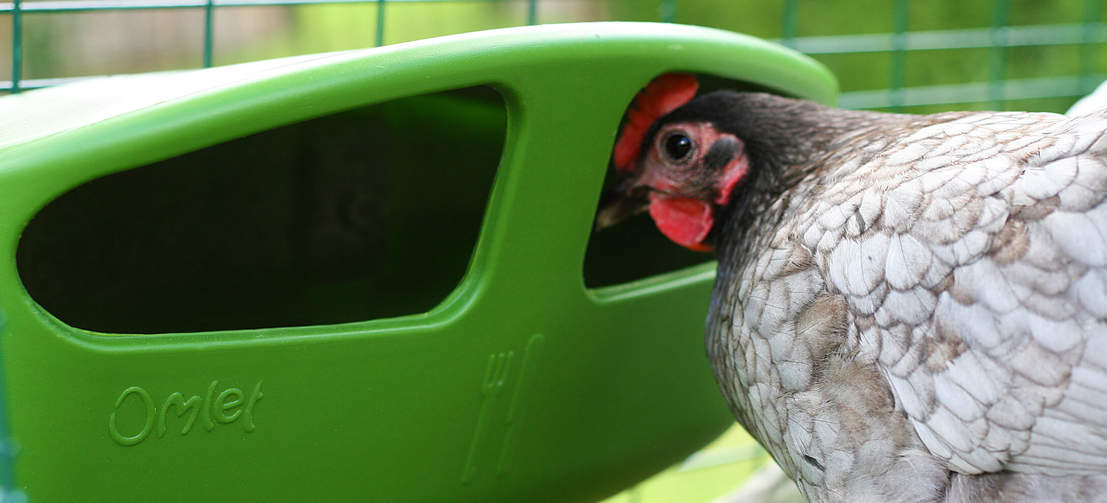
Chickens are great foragers, and free-range birds will peck and scratch for all kinds of wild treats, from grass and weeds to worms and beetles. However, even a hen with all-day access to a garden or meadow still needs to be fed with high-quality layers pellets. These contain the correct balance of protein, carbohydrate, vitamins and minerals (notably calcium for egg shells) that will keep them happy and healthy. Protein is particularly important for healthy egg production.
A general ballpark figure is very useful, to guarantee that the hens’ dietary requirements are being met. For medium-sized breeds such as the Rhode Island Red, Oxford Brown or Orpington, you need to feed between 115 and 120 grams (just over a quarter of a pound) of feed per chicken per day, which is 805 to 840 grams (one and a half pounds) of feed per chicken per week. A slightly larger Sussex will eat a bit more, and the smaller Leghorn will eat slightly less, while a small bantam breed will only eat between a half and three quarters of that amount.
Chicks, Pullets and Layers
Until it is five weeks old, a chick will need to have its diet supplemented with protein-rich ‘chick crumbs’. Between then and 18 weeks old, while they are ‘pullets’, the birds will need ‘growers pellets’ to put on weight. As soon as the hens begin laying, they only need the regular ‘layers pellets’. These, again, are rich in protein, calcium and all the other essential nutrients.
The hens will also need daily access to grit. Treats are fine, as long as they are not being offered so frequently that the hens fail to eat their share of pellets. Corn is a healthy treat, and birds that have free-range access to grass will be in chicken heaven.
How Can You Make Sure Each Hen is Getting Her Share of the Food?
Any flock of chickens develops a natural pecking order, and the dominant birds will tend to eat their fill before the others, if there is not enough space for all the hens to fill their crops at once (something they like doing shortly before retiring for the night). A solution here is to buy a wide-bottomed feeder that allows several birds to eat at once, or to use more than one feeder. This will ensure the timid hens get their fair share of food.
However, as long as you have provided enough for all your hens, there should always be food left in the feeder when the dominant birds have had their fill. You should still keep a close eye on the health of your flock, though. Issues such as soft shells or feather-plucking can be signs of dietary deficiencies, and the problem might lie in the quality rather than the quantity of the birds’ diet.
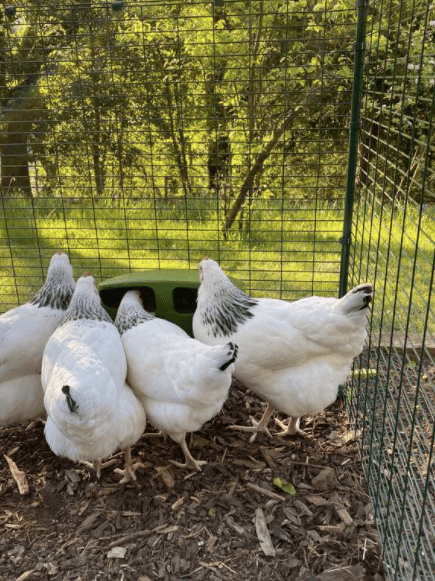
Do Hens Eat the Same Food All Year Round?
Chickens moult every year, and will usually eat more food during this process, to ensure their bodies have all the protein they need to grow a new set of feathers. Hens usually eat more during cold weather, too, in order to fuel their metabolisms and stay warm. Free-range hens also tend not to find as many treats in the garden during the winter, as the insect population is at low ebb and the grass is no longer growing.
You can add a little more food each day during these periods. You will soon know if you are giving them too much or too little, by noting the amount of pellets left in the feeder each evening.
However, the hens produce fewer eggs in the winter, so all in all the amount of protein-rich pellets required does not differ significantly from season to season. Again, the key detail is to ensure a regular supply of food. In the summer, if your hens appear to be eating very little, it may be because they are finding too many good things on their foraging trips in the garden. This can be a problem if the wild food they are filling up on doesn’t provide the right balance of nutrients. You might want to confine a hen to the coop if she doesn’t seem to eat enough pellets. That way, she will be forced to eat the good stuff rather than the garden treats.
Layers pellets should be available to your hens throughout the day – they will eat as much as they need, and will not behave like a dog, eating everything at once simply because it’s there!
This entry was posted in Chickens

Chickens really are wonderful pets for the whole family. Aside from providing delicious daily eggs, they’re super fun to watch, hang out with, and can teach children valuable life lessons. Compared to other pets, chickens are also relatively low maintenance, and caring for them doesn’t really require much that children from primary school age won’t be able to at least take part in. Read on to find out more reasons why chickens are great pets for families with children.
Responsibility
Having chickens will help children of all ages learn about taking responsibility for another living being. Whilst they should never be given full responsibility for all the chook care duties, even allowing them to scatter some corn for their feathered friends or refilling the drinker can help children build a wondrous connection and gain a better understanding of what it means to take care of another.
Routines
Chickens are pets of routine and part of your daily regime as a keeper includes, but is not limited to, cleaning out the coop and run, filling their feed and waterers and collecting eggs. Having pets that need structure helps children to understand the importance of a routine, which, is something many kids can thrive with,
Food
Keeping chickens will teach your children that food does not magically appear on supermarket shelves. If they care for their own chickens, they’ll hopefully realize how important it is for animals to have enough space and adequate care, and they will not take animal products for granted.
Chickens and children: things to consider
Dream big, start small
Whilst you might be tempted to start off with more, begin with a smaller flock of no more than 5 chickens. That way, your children will easily be able to differentiate them and give them names based on their personalities. Too many at once makes the chickens seem like a flock rather than a group of individuals. And at a later date, there’s nothing stopping you from falling victim to the infamous “chicken math” when your children are older!
Happy hens
Stick to hens. It’s probably a good idea not to get a rooster to start with. Whilst some chicken keepers have their own personal reasons as to why they want to keep cockerels, they’re not for everyone. For one, they’re much more confident and pushy than hens and can be a bit intimidating for younger children.
Easy peasy coop cleaning
Get a coop that makes chicken keeping easy, so that the kids can help. The Eglu Cube chicken coop is perfect for adults and children alike. With the innovative design, even younger members of the family can even help with the cleaning of the coop. Simply empty the dropping tray and wipe down the smooth surfaces of the house once a week, and your coop will look shiny and new every time.
It’s super easy to let the chickens out in the morning and close the coop at night too with the optional Autodoor. Plus, collecting fresh eggs is a breeze with the egg port found on the side of the coop.
Start them young
Even if you’re not incubating eggs and rearing chicks yourself, getting young chickens is a good idea if you want your children to be involved. Encourage regular interaction, and try to pick up the chickens regularly to get them used to being handled. This is sometimes made easier by having the chickens in a run that is easy to access, like the Walk In Run.
Which breed?
There are a number of chicken breeds to choose from, all of which with their own pros. When choosing chickens as family pets though, opt for a friendly and hardy breed that’s renowned for getting on well with kids. Silkies, for example, are famous for being loving and happy to be held, Orpingtons are calm and affectionate and Cochins easily adapt to any situation they are confronted with.
Omlet and your family pet
Whether you’re a first-time chicken keeper looking for a new family pet or expert, Omlet has everything you need to give your chooks the best lives possible. From our range of easy-to-clean chicken coops, to our Autodoor to take the guesswork out of bantam bedtime, chicken keeping has never been more simple or fun than with Omlet.

This entry was posted in Chickens
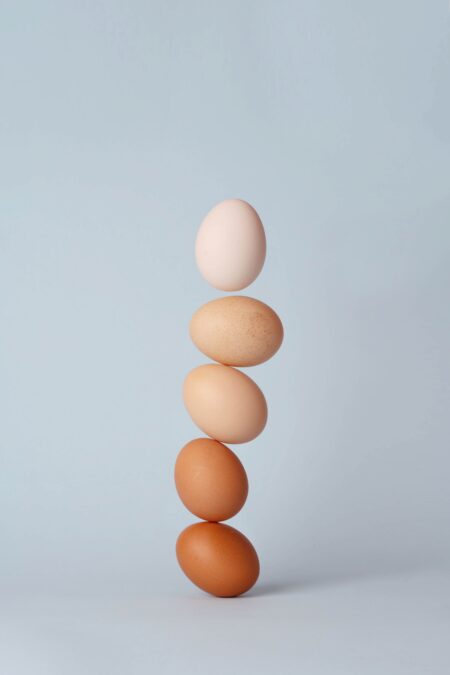 Most people would agree that the yolk is the best part of the egg. A double-yolker in the breakfast pan is therefore a very welcome sight!
Most people would agree that the yolk is the best part of the egg. A double-yolker in the breakfast pan is therefore a very welcome sight!
Some hens lay double-yolkers every time, a genetic quirk that simply means two yolks are released into the system instead of one. However, hens that manage this impressive feat are rare, and no single breed has been developed to pull off the double-yolk trick every time.
The one-egg-with-two-yolks breakfast can still be yours every day, though, if you’re willing to pay extra for it. You may have spotted double-yolk ‘super eggs’ on the shelves of certain supermarkets – sold at a premium, of course – but these are nearly all from young birds, rather than the mythical Double Yolker breed. It’s worth pointing this out, as a Google search will lead to some interesting information about such a breed. But it doesn’t exist – yet!
Most double-yolk eggs encountered by chicken keepers come from young hens. Point-of-lay birds tend to produce a very small egg or two, and then a couple of double-yolkers, before their bodies settle down into a regular four or five eggs-per-week pattern. A double-yolk egg after this early laying stage is very rare in most birds, although some hens begin to produce double-yolkers again towards the end of their egg-laying lives. Circumstantial evidence suggests that the Rhode Island Red, Oxford Brown, Sussex, and Leghorn breeds have a higher chance of producing double-yolkers.
How Are Double Yolks Formed?
Hens’ bodies release a yolk approximately two hours after the previous egg has been laid. Once in the hen’s oviduct – the part of the bird’s body in which the eggs are formed – the yolk is surrounded by the white albumen part of the egg and then covered in hard calcium. If a hen has released two yolks side-by-side, the egg-forming process treats them in the same way as a single yolk, resulting in two yolks ‘trapped’ inside a single egg shell.
If double-yolked eggs are fertilised, the result is two chicken embryos in one shell. Most of these ‘twin’ eggs fail to develop properly, though, with only one chick growing beyond the early development stage, or with neither of them developing. This makes it rare for two chicks to emerge from one egg. Chicken breeders are advised to put aside the double-yolkers to prevent them developing, and in commercial operations most double-yolkers are sold to food companies that use eggs in their products.
How Can You Tell If An Egg Has Two Yolks?
You don’t need to crack the shell to find out what’s inside – you can spot a double-yolker by ‘candling’ the egg. The word candling comes from the ancient practice of holding an egg in front of a candle flame, but a small torch does the job just as well (although they are still ‘candled’ rather than ‘torched’!) If there are two yolks inside, they will be visible as two dark blobs against the bright light as it shines through the shell.
So, although double-yolkers are estimated to occur in just one per thousand eggs, the sheer abundance of point-of-lay hens means that they are a common sight on the plates of chicken keepers around the world.
Triple yolkers, however, are very unlikely to grace the breakfast table. This super-rarity is found in just one egg per 25 million!
This entry was posted in Chickens
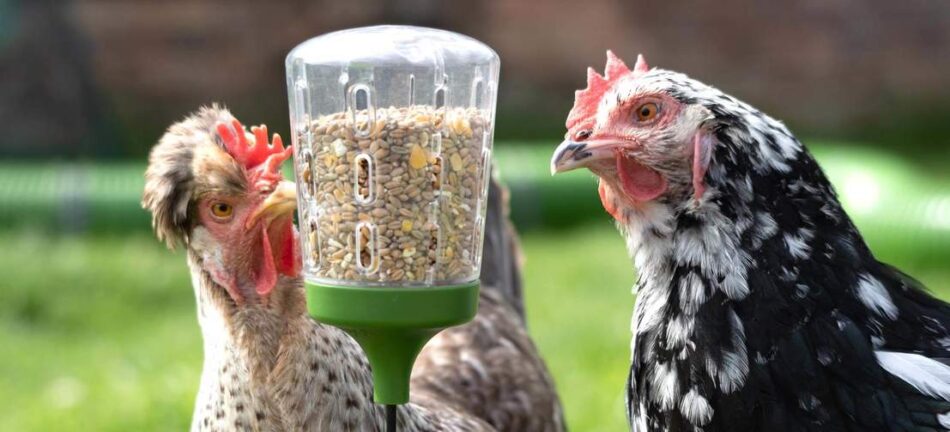
The very short answer to that question is probably no. If you give your chickens a good quality feed and some corn, and let them peck around the garden for insects and small stones they use to grind down their food they should technically be getting everything they need.
Any supplement should be given to your chickens as a complement to a healthy and balanced diet, and not instead of giving them good feed or sufficient space to live out natural chicken behaviours. However, just like you might boost your own system with some extra vitamins and minerals, there are some things that you can give your hens that will help them stay healthier and give them more energy.
Particularly useful at more challenging times, like around a moult or during a particularly tough cold snap, we’ve listed all the supplements you might want to have in your cupboard:
Grit
Chickens don’t have teeth, but use small rocks and stones to grind their food down. Most free range chickens gather grit naturally while exploring the garden, but if you for some reason have to contain your chickens to a smaller area than normal, or if their run is covered in snow, you might need to add grit to their diet.
Make sure to choose something that is chicken specific and will have the right composition and size of components.
Vinegar
Vinegar, normally Apple Cider Vinegar, is a great booster all year around. It aids digestion, keeps internal parasites at bay, and is mildly antiseptic. In the winter it’s also fantastic to use preventatively to keep respiratory infections away from your flock.
Choose an organic or unpasteurised vinegar that contains a substance called ‘the mother’. It’s a gel-like substance that grows naturally on the vinegar, and it’s the mother that contains the most powerful enzymes and minerals that make the vinegar so beneficial.
Vinegar can be added to the chickens’ drinking water, approximately 10ml per liter of water.
Garlic
As well as keeping vampires away, garlic has been used for its beneficial properties for centuries, and it’s a great addition to your chickens’ diet.
You can crush up a fresh clove or use garlic powder to add to the feed. It’s great for circulation, and can help with respiratory infections. It’s also said to help ensure a good appetite, so it’s ideal to give it to newly rescued hens that need a nutrient boost.
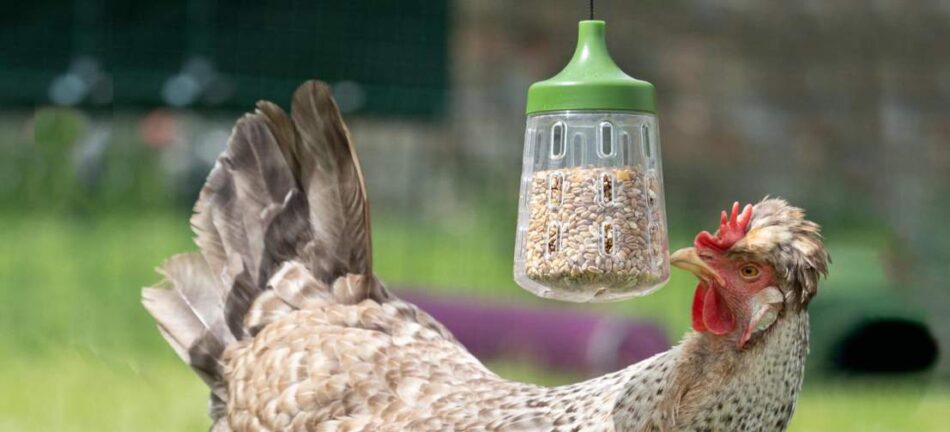
Herbs
Plenty of herbs and spices are said to have medicinal properties that will help your hens keep their immune system in top condition. Verm-X is a 100% natural supplement that helps maintain intestinal hygiene and keeps the hen’s gut and digestive system in great condition, which can help keep parasites and infections away.
Oregano, cinnamon, parsley, turmeric and ginger are other chicken favourites that will increase vitamin levels and aid the immune system, and that grinded down can be mixed into your chickens feed.
Calcium
Chickens use lots of calcium to build egg shells, so laying chickens can sometimes need a little more than they get from their pellets.
Equimins Egg Shell Improver is a great example of a supplement that contains high levels of calcium and phosphorus and will strengthen the quality of your chickens’ eggs. Ideal for ex battery hens or hens going through a moult.
Poultry Spice
This is a long term favourite with chicken keepers, a mineral supplement that will be beneficial to your chickens’ general health. It’s perfect for moulting, or to help maintain good appetite in winter.
This entry was posted in Chickens
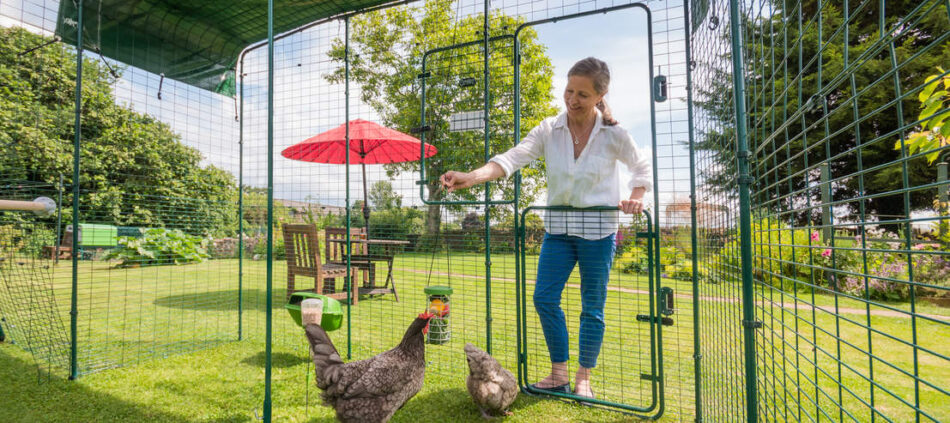
1. You have created a social media page for your Hens
Let’s face it, when you invest in a chicken coop and purchase your first flock you have to share it with friends and family. Whether it is documenting first eggs laid in the coop to your gourmet recipes with your farm-fresh eggs you are posting it on Instagram, Facebook, or Twitter.
2. You find eggs throughout the house
As you start becoming more comfortable with your chickens maybe you decide to let them into your home. They never bother anybody and get along great with your other pets but occasionally you find a fresh egg in your fruit bowl or on top of your favourite armchair. Hey, at least you know they are comfortable!
3. A “staycation” is your idea of a holiday
When you invest in your first brood you feel like you are a second parent to these animals. You wash them, feed them, and make sure they are comfortable. Add that in with taking care of your own kids and the idea of going on holiday is the last thing on your mind. You would much rather set up a zoom background of the beach or the tropics, order in a favourite meal, and put your feet up. Ahhh!
4. You find yourself chatting with your chickens
Sometimes we just need a good therapy session with an attentive listener, and who better than your chickens. They will never talk back to you or judge you for your decisions. They may give the occasional nudge or peck for a pet but hey, it is cheaper than therapy.
5. You have pet names for your hens
After the first couple weeks of tending to your chickens you start noticing some have different personalities. Some are on the shy side, some are very particular about their feeding time, and some just want all of the cuddles in the world. What a perfect time to give them a name! Whether it is Rudy, Cleo, or Fluffy we don’t judge here because they are your pets.
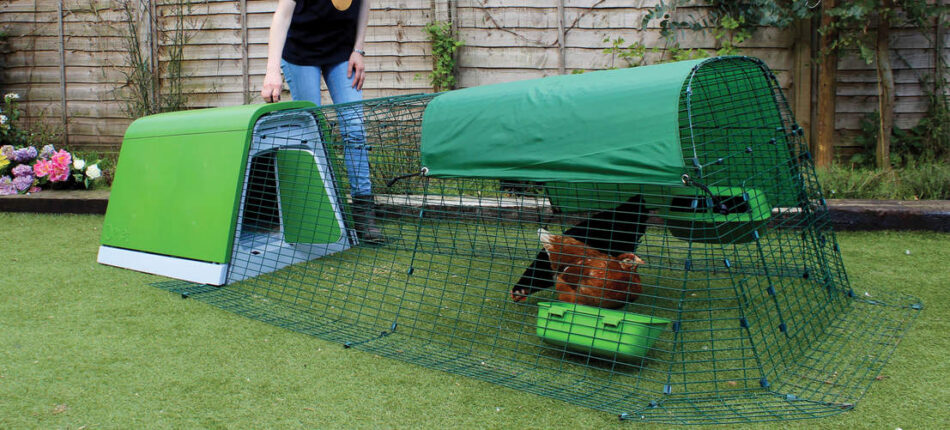
6. The home is filled with fashionable fowl décor
Whether it is chicken cocktail napkins or a hen-tastic serving platter you or your friends have made sure that you have all of the latest in chicken-related home furnishings.
7. You have a carrier bag to transport your chickens
Maybe you need to take them to the vet like any of your other pets. Who says that they shouldn’t be comfortable? That is why you have the top of the line carrier to transport your chickens whenever they are unwell.
8. Dressing up your brood for special occasions
When you have spring chickens or fall fowls they must be dressed for the season. When Halloween comes around you wouldn’t put it past yourself to dress up your chickens in a matching outfit with your other pets.
9. Instead of walking the dog you find yourself walking the flock
Yes, there are harnesses for chickens because you have already researched it on Amazon. Maybe you have limited land and your chickens need to stretch their legs each day, so you take them to the local park to graze and get some fresh air. Totally normal, right?!
10. You find yourself building a chicken picnic table for feeding time
We have all seen the trend of building mini picnic tables for our squirrel friends in our backyard. If you haven’t just Google it and you will be entertained by these structures. Well, who says your chickens should have any less than the squirrels. You paint your own table to pour your chicken feed into each day so your chickens can chow down in style.
At the end of the day, we understand that when you decide to venture out into the land of chicken coops it can be a daunting process. Everyone has unique experiences and should be able to tend to their hens/ roosters in their own way. Your flock is part of your family so why skimp on their care and upkeep!
This entry was posted in Chickens
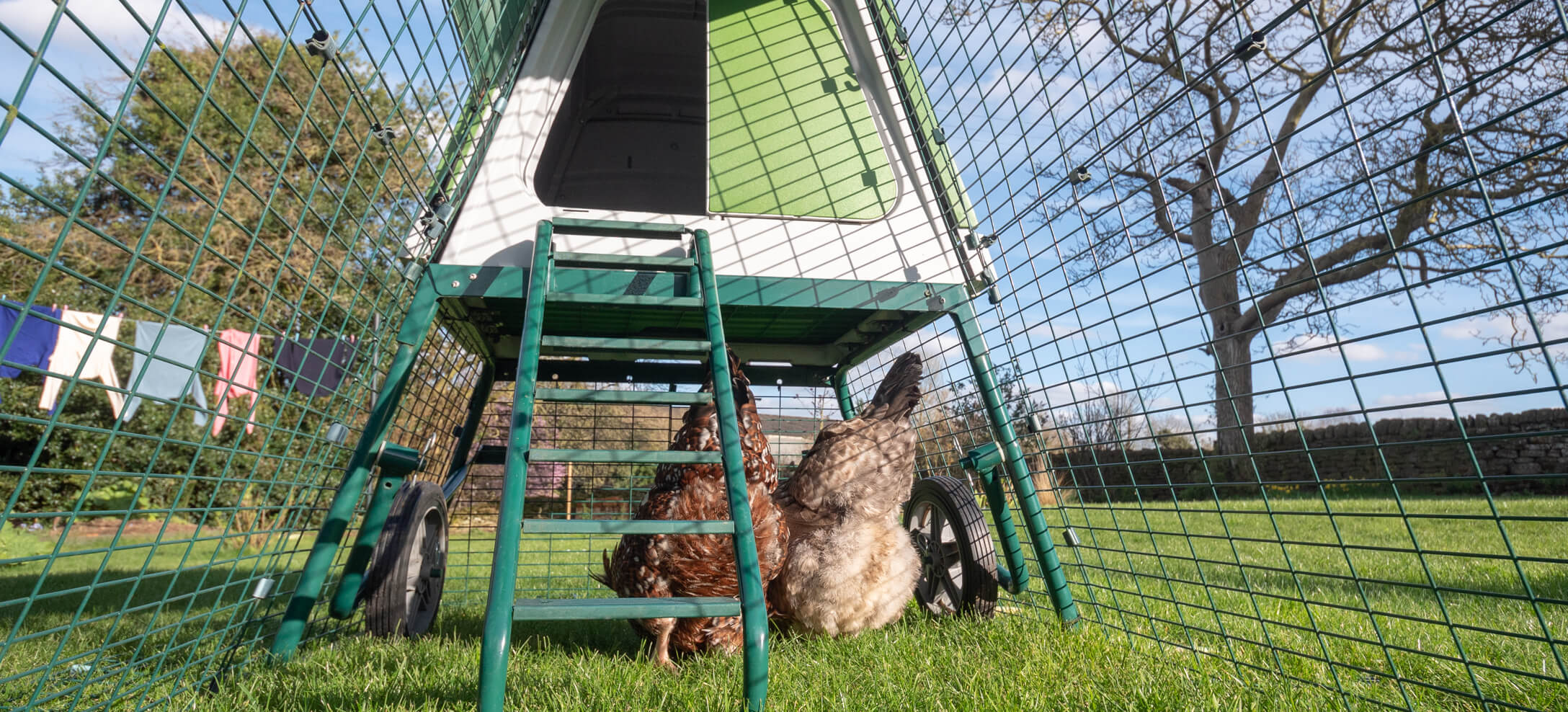
Like most other animals, chickens can suffer from parasitic worms. These are endoparasites that live inside your bird’s body, and are collectively called Helminths by vets.
Does my chicken have worms?
The three types of parasitic worms that your chickens are most likely to contract are:
- Roundworms. There are a number of different roundworms, with the large roundworm being the most common. They live anywhere in the bird’s digestive system, and can sometimes be spotted in your chickens’ droppings.
- Gapeworms. These nasty parasites attach themselves to the trachea of the chicken, hooking on without moving.
- Tapeworms. These attach themselves to the lining of the intestine and can get really long and unpleasant. They are less common, but will more significantly affect the bird.
It’s not always straightforward to tell if your chicken has worms, but symptoms may include a paler comb, decreased egg production, diarrhoea and increased appetite without weight gain. A chicken who has been infected with gapeworm will stretch their neck and gasp for air. Sometimes you won’t spot an infection until it’s really serious and possibly untreatable.
To worm or not to worm
Many chicken keepers therefore choose to worm their chickens regularly to prevent them getting infected, usually once in spring and once in autumn. This is normally done using Flubenvet, a poultry specific wormer you can get at the vets that will kill both the worms and their eggs. Make sure you get a worming treatment that is suitable for chickens, and check if you should be discarding the chicken’s eggs while she is being treated. Always worm all chickens at the same time.
Other chicken keepers think it’s better to only treat chickens that have a confirmed infection. This is partly because some wormers are only effective on particular parasites, and will be pointless if your chickens have a different type of worm. Some also think it’s unnecessary to stress the system by giving the birds treatment for an issue they might not have. Additionally, it can be pricey to worm a whole flock twice a year.
If you don’t want to treat your chickens without a diagnosis, but suspect they might have worms, you can get their droppings tested for presence of eggs. Ask your vet if they will do it for you, or you can send the droppings off to a laboratory in pre-made kits.
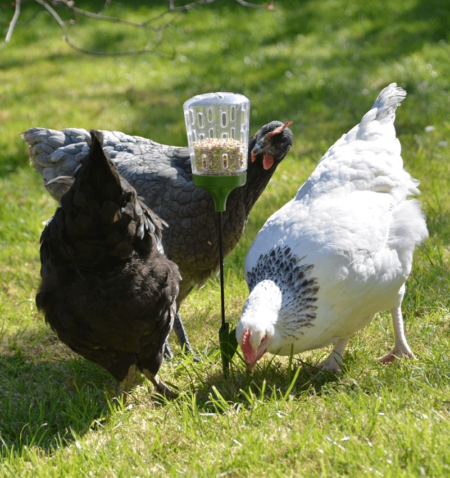 Prevent infections
Prevent infections
Whether you decide to treat only confirmed worm cases or worm preventatively, it’s always best to do everything you can to make sure your chickens don’t contract parasites.
One of the best things to do is to regularly move their coop and run to a new patch. This will stop serious outbreaks, as it stops the life-cycle of the worms. Worm eggs are expelled in the droppings from infected birds, and survive on the ground for a surprisingly long time before they are picked up by foraging chickens. This is called a direct life-cycle, as the worm doesn’t need a host animal to get to your hens. Worms that have an indirect life-cycle on the other hand let their eggs first be ingested by for example earthworms, slugs or centipedes, where they lay dormant until the host is eaten by one of your chickens. The larvae hatch inside your hens, and the cycle repeats.
To prevent an unbreakable chain of worm infestations, it’s therefore important to regularly move your chickens. This is made easy by portable chicken coops like the Eglu Cube or the Eglu Go UP.
Another useful thing is to keep the grass mowed as the ultraviolet light from the sun can kill off potential worm eggs in your chickens’ droppings. Clean the run every week and scoop up droppings and wet bedding. If one of your chickens is infected it’ll be very difficult to get rid of all worm eggs from the ground, but every little helps!
Finally, many chicken keepers swear by the mineral supplement Verm-X. It’s a herbal formulation that works to create an environment in the gut that is able to eradicate and expel any intestinal challenges. This can be given as a supplement to your flock regularly to help their immune system stay on top.
This entry was posted in Chickens

Take this opportunity to get some good quality feed that will keep your chickens happy and healthy this autumn! When you sign up to the Omlet Newsletter on this page (for the feed) or this page (for the Easichick Bedding), you will receive a unique promo code that gives you free delivery on your feed or bedding – for a limited time only!
The offer is available on your pick of two bags of Omlet’s Organic Chicken Feed, Omlet’s Organic Mixed Corn, Organic Omlet Chicken Feed 10kg and Mixed Corn 10kg or Organic Omlet Chicken Feed 10kg Twin Pack, or two bags of Easichick Bedding!
Terms and conditions
This promotion is valid while stocks last, until midnight 05/11/20. Once you have entered your email address on the website you will receive a unique discount code that can be used at checkout. By entering your email you agree to receive the Omlet Newsletter. You can unsubscribe at any point. The offer of free delivery is available on Omlet’s Organic Chicken Feed, Omlet’s Organic Mixed Corn, Organic Omlet Chicken Feed 10kg and Mixed Corn 10kg and Organic Omlet Chicken Feed 10kg Twin Pack, or Easichick Bedding. The offer does not include any non-Omlet branded feed. Excludes grit. Excludes any other type of bedding. Offer is limited to 2 bags of feed per household, or 2 bags of Easichick. Free delivery only applies to the included products, delivery charges will be added for other items added to the order. Free delivery offer is not redeemable on pallet deliveries. Omlet cannot take responsibility for third party supplier delays such as courier service. Free delivery is only valid for orders sent to mainland UK, and only applies to Standard Delivery Service. Subject to availability. Omlet ltd. reserves the right to withdraw the offer at any point. Offer cannot be used on existing discounts or in conjunction with any other offer.
This entry was posted in Chickens
Making sure your flock is healthy and happy is the responsibility of all chicken keepers. Knowing how to give your chicken a health check will enable you to see that all of your hens are feeling their healthiest. When combined with adequate shelter, nutrition, and enrichment, regular health checks will help your chickens live long, healthy lives. Learn when and how to give your chickens health checks, and familiarise yourself with what’s normal so that you can recognise when something is amiss.

Why are chicken health checks important?
Like other pets, injuries and illness can occur in chickens. Since chickens are prey animals, they are masters at hiding pain and weakness. So while some illness or injuries may seem to occur suddenly to the untrained eye, there may be subtle hints that can be detected through routine health checks.
Routine chicken health checks will also give you a baseline for what’s “normal” for each individual hen. By knowing how your chickens normally look and feel, you’ll be able to more quickly identify a potential issue. Time is of the essence when your chickens are feeling “off” — making regular health checks a vital part of your flock-care routine.
How often should I give my chickens a health check?
It’s likely that you’ll observe your chickens daily as they go about their business in the yard or run. But weekly chicken beak-to-tail health checks are best for heading off potential problems. Each week, handle your hens and go through this checklist:
Eyes
Your chicken’s eyes should be clear, bright and fully open. Any amount of discharge, whether clear and watery or thick and yellow or green, is abnormal. Their eyes should also be properly lubricated and not appear dry, and third eyelids should slide easily and retract fully.
Nose
Nostrils, or nares as they are called in chickens, are located on the top of the beak near the eyes. Nares should be clean and free from debris, and should not have any discharge. Breathing sounds should not be audible.
Beak
Your chicken’s beak should be smooth, without cracks or other damage. The top and bottom should align, with the top being slightly longer. Healthy chickens keep their beak closed most of the time.
Comb
A grown chicken who is not broody or moulting should have a firm, bright red comb. It should be positioned according to the breed standard, i.e. if the breed’s comb is upright, it should not be hanging or looking shrivelled.
It’s especially important to check combs and wattles in winter, as they are prone to frostbite. Larger combs can be protected by a daily layer of vaseline.
Crop
Chickens have a “crop” at the base of their esophagus that holds their food before it’s moved through the rest of their digestive system. You can feel the crop by palpating by the breastbone of your chicken at the base of their neck. It’s easiest to feel when your chicken has just eaten — it will feel firm and about the size of a golf ball. Empty crops usually can’t be felt.
When you first let your chickens out in the morning their crops should be empty, as they should have spent all night digesting their food. After eating, the crop will feel firm, but not rock-hard. If it never feels empty, full even after not having food all night, or if your hen’s breath is foul smelling, you could be dealing with an impacted or sour crop.
Feathers
With the exception of molting season in chickens, your hens’ plumage should be full and shiny. Bald patches, broken feather shafts, or unkept feathers can all be signs of stress, parasites, or behavioural concerns.
Legs and feet
Your chicken’s legs should appear smooth, with the scales lying flat against the bone — raised or dry scales can be an indication of scaly leg mites. The bottoms of the feet should be smooth and free of cuts, discoloured spots, or bumps. Large bumps on the bottoms of the feet can indicate bumblefoot in chickens, which is a bacterial infection.
Vent
The vent, or cloaca, of chickens is where eggs and eliminations are expelled from the hen’s body. Laying-age hens have pink, wide, and moist vents, while vents in older hens may appear dry and more pale. Healthy vents should never protrude or appear injured. Mites and lice gravitate toward this area, so check for black specks of debris or skin irritation.
Droppings
Slide out dropping trays, like those on Eglu chicken coops, help you keep an eye on your flocks eliminations. Chicken droppings should be formed and somewhat firm, and dark brown in colour. Loose, white portions on these droppings are also normal. Your chickens’ droppings will vary depending on their diet for the day, but should always revert back to “normal” within a day or two of eating new or diverse foods. Extended periods of loose stool, or bloody stool is an indication of illness or stress.
What to do if your chickens aren’t feeling their best
If any of your findings during the chicken health check are abnormal, it’s best to separate the affected hen from the rest of the flock and contact your veterinarian for further guidance. Make sure that you have a veterinarian that treats poultry as a point of contact. Some veterinarians may be able to come to you, or give you advice over the phone on how to proceed with any chickens that feel under the weather or that appear injured.
Isolate ill or injured hens until their symptoms have cleared, or until you’re advised by your veterinarian that it’s ok to reintroduce them back into the flock. Having a back up chicken coop to serve as a hospital wing or quarantine coop is always a good idea. This will ensure that the chickens that any chickens that aren’t feeling their best will still be housed in the best accommodations possible — which will help aid in reducing their stress and boosting their recovery.
Omlet and your healthy hens
A healthy flock starts with their housing and care. Our chicken coops are easy to clean, and offer the support and security that your flock needs. When they’re not sleeping or laying eggs in their coop, your hens will enjoy their time outside safely inside our walk in chicken runs, protected from predators. Add chicken run weather covers, and your flock will be ready to enjoy healthy, happy seasons in their home with you.
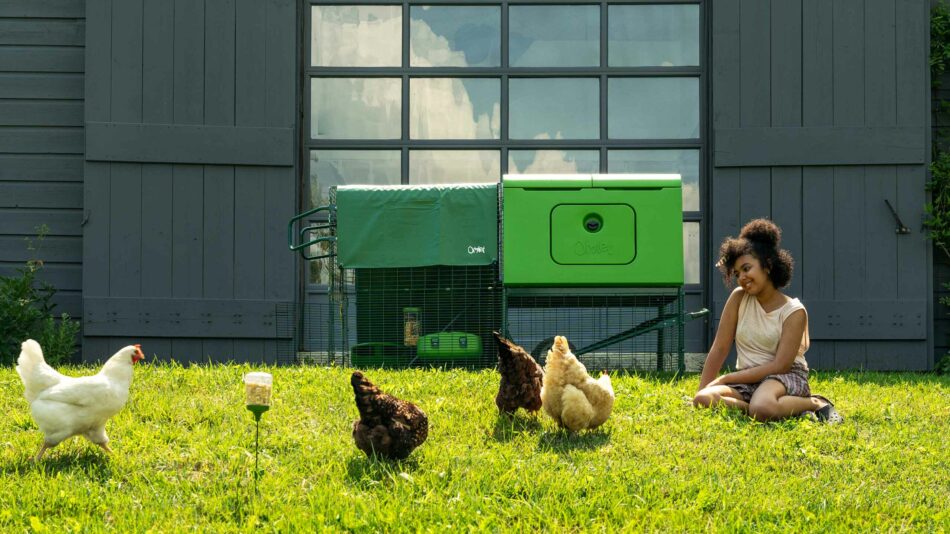

This entry was posted in Chickens
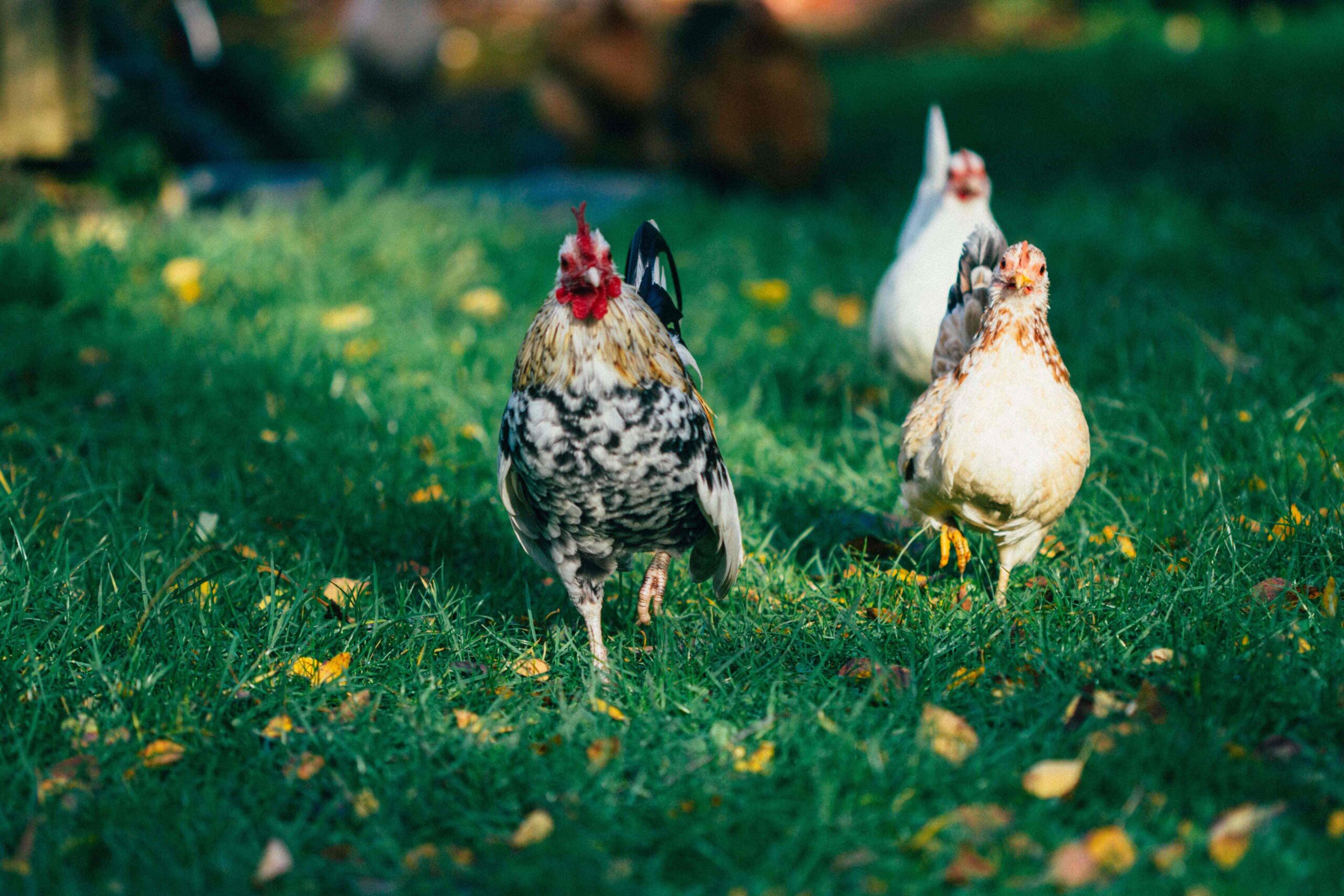
Chickens are colour blind
FALSE – Chickens actually have superior colour vision to humans. Thanks to five light receptors in the eye (humans only have three), they can see many colours more vividly than us.
Chickens can be half male, half female – split down the middle
TRUE – Due to a phenomena called bilateral gynandromorph there are chickens where one side of the body is male (large wattle, spur and muscular breast etc.) and the other side is female (duller plumage, smaller comb, slighter build etc). Worth a google!
There are as many chickens as there are humans on earth
FALSE – There are almost 4 times as many chickens as there are humans, more than 25 billion. In fact, there are more chickens in the world than any other bird.
Chickens navigate through magnetic fields
TRUE – Like other birds, chickens use the magnetic fields of the earth to orientate themselves and navigate around their home environment. Additionally, studies show that chickens use the sun to tell the time of day. Daylight intensity is also what tells cockerels when to crow in the morning and when to go roost at night.
Chickens are cannibals
UNDECIDED – You might have heard about cannibalism in poultry, and it does happen that chickens start pecking the flesh of other hens. This is however not a natural behaviour seen in the wild, but a result of a stressful environment with limited space in large egg or meat factories. A happy chicken will not eat its friend.
Chickens have no taste buds

FALSE – While it may seem like chickens will eat just about anything you put in front of them, they do have taste buds, and personal preferences. A chicken can’t taste sweetness or spiciness, but can tell saltiness, sourness and bitterness apart.
The colour of the egg affects the nutritional content
FALSE – Despite what some egg producers have claimed during the years, brown eggs are not healthier than white ones, or vice versa. The colour of the shell only depends on the breed of chicken it came from, and will have no impact on taste or nutritional content.
If you chop their heads off, chickens will keep running
TRUE – Some chickens will indeed keep running after having their head chopped off. The pressure from the axe triggers nerve endings in the neck, sending a message back to the muscles telling them to move, without the brain actually being involved.
The chicken is then moving while actually being dead, but in the case of Miracle Mike, the farmer who tried to kill him aimed a bit high and accidentally left a bit of the brain that chickens keep at the back of their necks. This made it possible for Mike to live for another 18 months (!) after his head had been removed.
You can hypnotise a chicken
TRUE – There are several ways of putting a chicken in a trance, but the most common one involves holding the chicken with its head close to the ground, and drawing a line in the ground going outwards from the beak. This will paralyse the chicken, and she will stay laying still until you clap or poke her.
While it probably won’t hurt your chicken to hypnotise it like this, it’s unclear how much stress it causes her, so make sure not to do it too frequently.
This entry was posted in Chickens















 If your hens are very tame, you can simply offer some treats, bend down and pick them up. If only it were that easy with every chicken! Some are about as easy to catch as a fast-moving bar of wet soap – they can sprint at speeds of around 9 miles (14.5 km) per hour – and you will usually have to corner them first if you want to catch them.
If your hens are very tame, you can simply offer some treats, bend down and pick them up. If only it were that easy with every chicken! Some are about as easy to catch as a fast-moving bar of wet soap – they can sprint at speeds of around 9 miles (14.5 km) per hour – and you will usually have to corner them first if you want to catch them.








 Most people would agree that the yolk is the best part of the egg. A double-yolker in the breakfast pan is therefore a very welcome sight!
Most people would agree that the yolk is the best part of the egg. A double-yolker in the breakfast pan is therefore a very welcome sight!




 Prevent infections
Prevent infections




